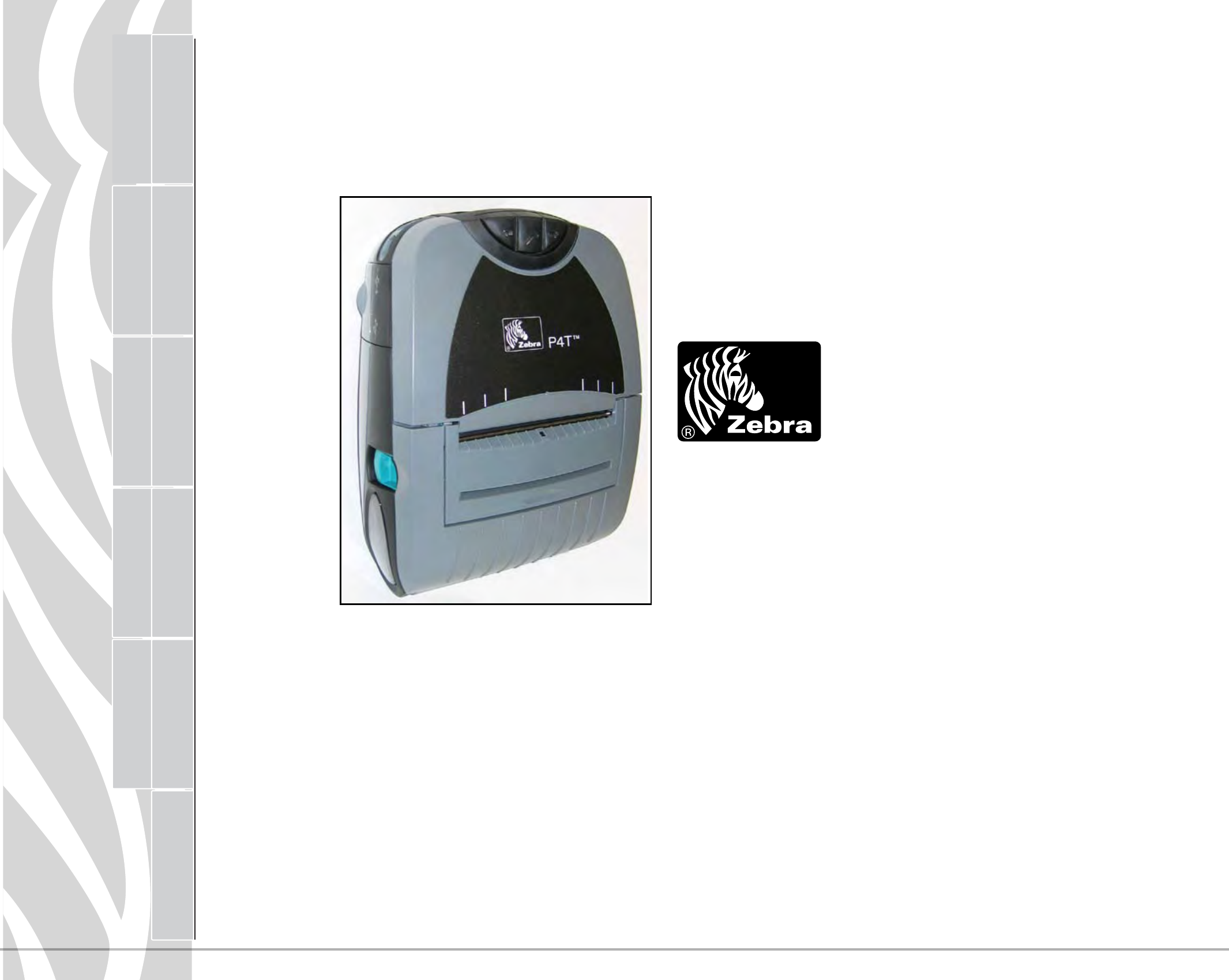Zebra Technologies RFID-R4CXNG-01 P4T with Zcomax WiFi plus RFID radio User Manual UMAN P4TB3
Zebra Technologies Corporation P4T with Zcomax WiFi plus RFID radio UMAN P4TB3
Contents
User Manual 1 of 3
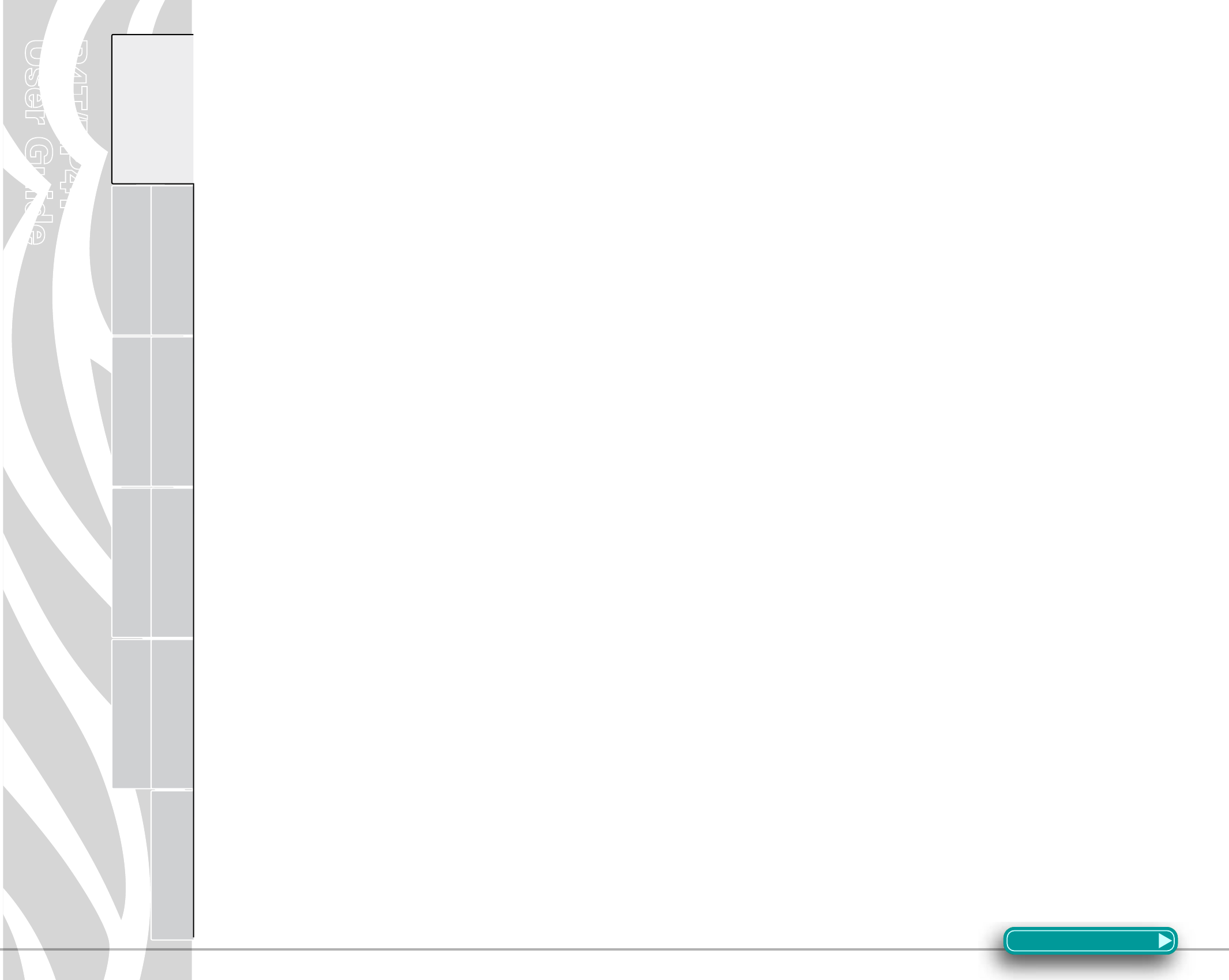
P4T/RP4T
User Guide
2
P4T Overview
Manual
Introduction Printer Preparation Connecting the
Printer
Radio Regulatory
Information
RP4T Printers Maintenance Troubleshooting Specifications Appendices Index
Proprietary Statement
This manual contains proprietary information of Zebra Technologies Corporation.
It is intended solely for the information and use of parties operating and
maintaining the equipment described herein. Such proprietary information may
not be used, reproduced, or disclosed to any other parties for any other purpose
without the expressed written permission of Zebra Technologies Corporation.
Product Improvements
Since continuous product improvement is a policy of Zebra Technologies
Corporation, all specifications and signs are subject to change without notice.
FCC Compliance Statement
This device complies with part 15 of the FCC Rules. Operation is subject to the
following two conditions: (1) This device may not cause harmful interference, and
(2) this device must accept any interference received, including interference that
may cause undesired operation.
NOTE: This equipment has been tested and found to comply with the limits or
a Class B digital device, pursuant to Part 15 of the FCC Rules. These limits are
designed to provide reasonable protection against harmful interference in a
residential installation. This equipment generates, uses and can radiate radio
frequency energy and, if not installed and used in accordance with the instructions,
may cause harmful interference to radio communications. However, there is
no guarantee that interference will not occur in a particular installation. If this
equipment does cause harmful interference to radio or television reception, which
can be determined by turning the equipment off and on, the user is encouraged to
try to correct the interference by one or more of the following measures:
•Reorientorrelocatethereceivingantenna.
•Increasetheseparationbetweentheequipmentandreceiver.
•Connecttheequipmentintoanoutletorcircuitdifferentfromthattowhich
the receiver is connected.
•Consultthedealeroranexperiencedradio/TVtechnicianforhelp.
WARNING: Exposure to Radio Frequency radiation. To conform to FCC RF
exposure requirements this device shall be used in accordance with the operating
conditions and instructions listed in this manual. Note that there are several radio
options available with this printer. Additional regulatory information is contained
in later sections devoted to each radio individually.
NOTE: This unit was tested with shielded cables on the peripheral devices.
Shielded cables must be used with the unit to insure compliance.
Changes or modifications to this unit not expressly approved by Zebra
Technologies Corporation could void the user’s authority to operate this
equipment.
Canadian Compliance Statement
This Class B digital apparatus complies with Canadian ICES-003.
Cet appareil numérique de la classe B est conforme á la norme NMB-003 du
Canada.
“IC:” before the equipment certification number signifies that the Industry Canada
technical specifications were met. It does not guarantee that the certified product
will operate to the user’s satisfaction.
Agency Approvals and Regulatory Information
•FCCpart15 •CanadianSTDRSS-210
•NOM-ETL(Mexico) •EN60950:2000SafetyStandard
•EN55022:1998ClassBEuropean •C-Tick(Australia)
Electromagnetic Radiation Standard
Liability Disclaimer
Inasmuch as every effort has been made to supply accurate information in
this manual, Zebra Technologies Corporation is not liable for any erroneous
information or omissions. Zebra Technologies Corporation reserves the right to
correct any such errors and disclaims liability resulting therefrom.
No Liability for Consequential Damage
In no event shall Zebra Technologies Corporation or anyone else involved in the
creation, production, or delivery of the accompanying product (including hardware
and software) be liable for any damages whatsoever (including, without limitation,
damages for loss of business profits, business interruption, loss of business
information, or other pecuniary loss) arising out of the use of or the results of use
of or inability to use such product, even if Zebra Technologies Corporation has
been advised of the possibility of such damages. Because some states do not
allow the exclusion of liability for consequential or incidental damages, the above
limitation may not apply to you.
Copyrights
The copyrights in this manual and the label print engine described therein are
owned by Zebra Technologies Corporation. Unauthorized reproduction of this
manual or the software in the label print engine may result in imprisonment of up
tooneyearandnesofupto$10,000(17U.S.C.506).Copyrightviolatorsmaybe
subject to civil liability.
ThisproductmaycontainZPL®,ZPLII®,andZebraLinktm programs; Element Energy
Equalizer® Circuit; E3®; and AGFA fonts. Software © ZIH Corp. All rights reserved
worldwide.
ZebraLinkandallproductnamesandnumbersaretrademarks,andZebra,the
Zebralogo,ZPL,ZPLII,ElementEnergyEqualizerCircuit,andE3Circuitare
registeredtrademarksofZIHCorp.Allrightsreservedworldwide.
Monotype®, Intellifont® and UFST®aretrademarksofMonotypeImaging,Inc.
registeredintheUnitedStatesPatentandTrademarkOfceandmayberegistered
in certain jurisdictions.
AndyTM , CG PalacioTM,CGCenturySchoolbookTM, CG TriumvirateTM, CG TimesTM,
Monotype KaiTM, Monotype MinchoTM and Monotype SungTMaretrademarksof
Monotype Imaging, Inc. and may be registered in some jurisdictions.
HY Gothic HangulTMisatrademarkofHanyangSystems,Inc.
AngsanaTMisatrademarkofUnityProgressCompany(UPC)Limited.
Andale®, Arial®,BookAntiqua®, Corsiva®, Gill Sans®, Sorts® and Times New
Roman®aretrademarksofTheMonotypeCorporationregisteredintheUnited
StatesPatentandTrademarkOfceandmayberegisteredincertainjurisdictions.
CenturyGothic™,BookmanOldStyleTMandCenturySchoolbookTMaretrademarks
of The Monotype Corporation and may be registered in certain jurisdictions.
HGPGothicBisatrademarkoftheRicohcompany,Ltd.andmayberegisteredin
some jurisdictions.
UniversTMisatrademarkofHeidelbergerDruckmaschinenAG,whichmaybe
registeredincertainjurisdictions,exclusivelylicensedthroughLinotypeLibrary
GmbH,awhollyownedsubsidiaryofHeidelbergerDruckmaschinenAG.
Futura®isatrademarkofBauerTypesSAregisteredintheUnitedStatesPatent
andTrademarkOfceandmayberegisteredinsomejurisdictions.
TrueType®isatrademarkofAppleComputer,Inc.registeredintheUnitedStates
PatentandTrademarkOfceandmayberegisteredincertainjurisdictions.
Allotherbrandnames,productnames,ortrademarksbelongtotheirrespective
holders.
©2008ZIHCorp.
Section Continues
This device complies with Industry Canada licence-exempt RSS standard(s).
Operation is subject to the following two conditions: (1) this device may not
cause interference, and (2) this device must accept any interference,
including interference that may cause undesired operation of the device.
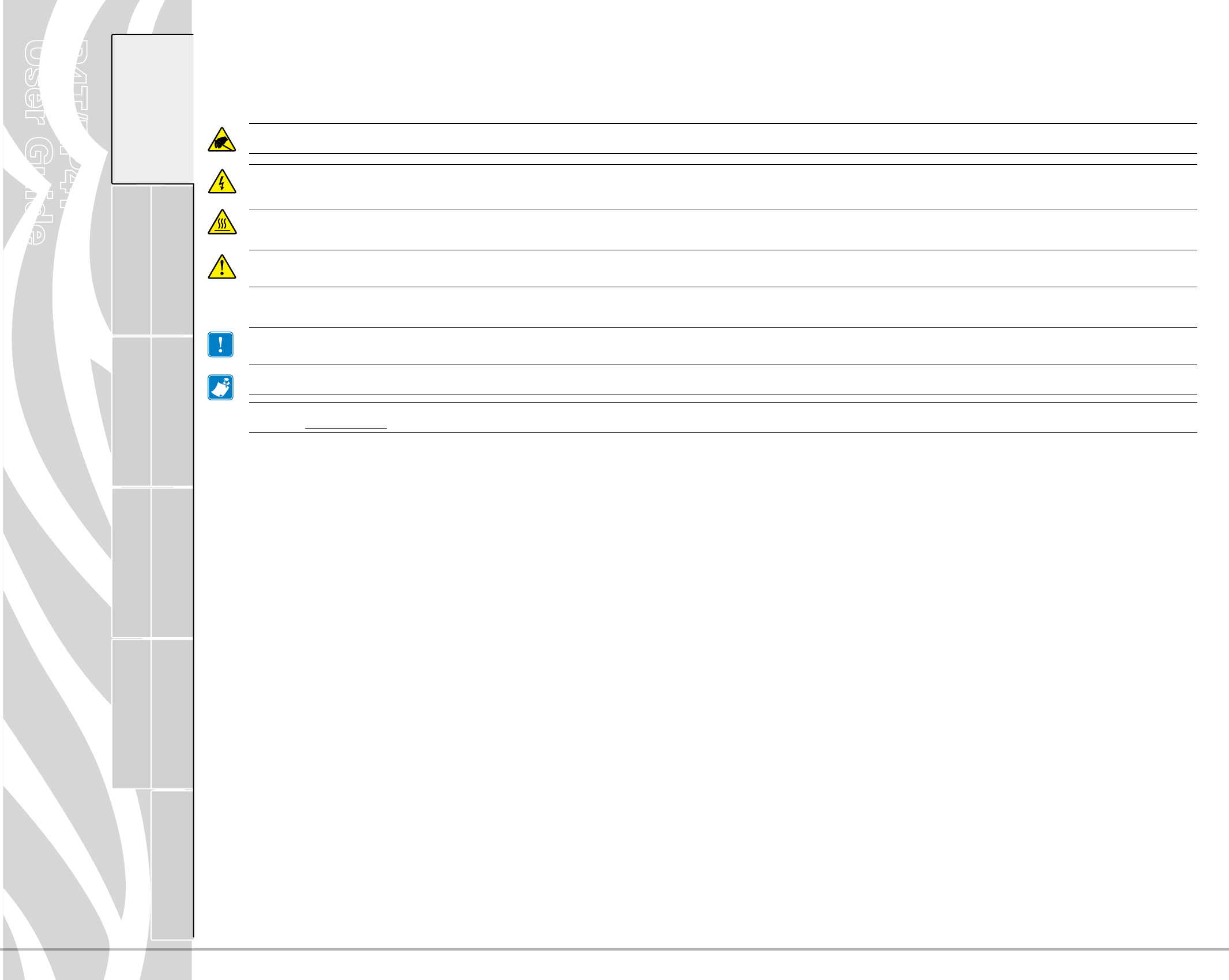
P4T/RP4T
User Guide
3
P4T Overview
Manual
Introduction Printer Preparation Connecting the
Printer
Radio Regulatory
Information
RP4T Printers Maintenance Troubleshooting Specifications Appendices Index
Document Conventions
The following conventions are used throughout this document to convey certain information:
Caution•Warnsyouofthepotentialforelectrostaticdischarge.
Caution•Warnsyouofapotentialelectricshocksituation.
Caution•Warnsyouofasituationwhereexcessiveheatcouldcauseaburn
Caution•Advisesyouthatfailuretotakeoravoidaspecicactioncouldresultinphysicalharmtoyou.
Caution•Advisesyouthatfailuretotakeoravoidaspecicactioncouldresultinphysicalharmtothehardware.
Important•Advisesyouofinformationthatisessentialtocompleteatask.
Note•Indicatesneutralorpositiveinformationthatemphasizesorsupplementsimportantpointsofthemaintext.
Textinthisformatwilljumptotheappropriatesectioninthemanual.
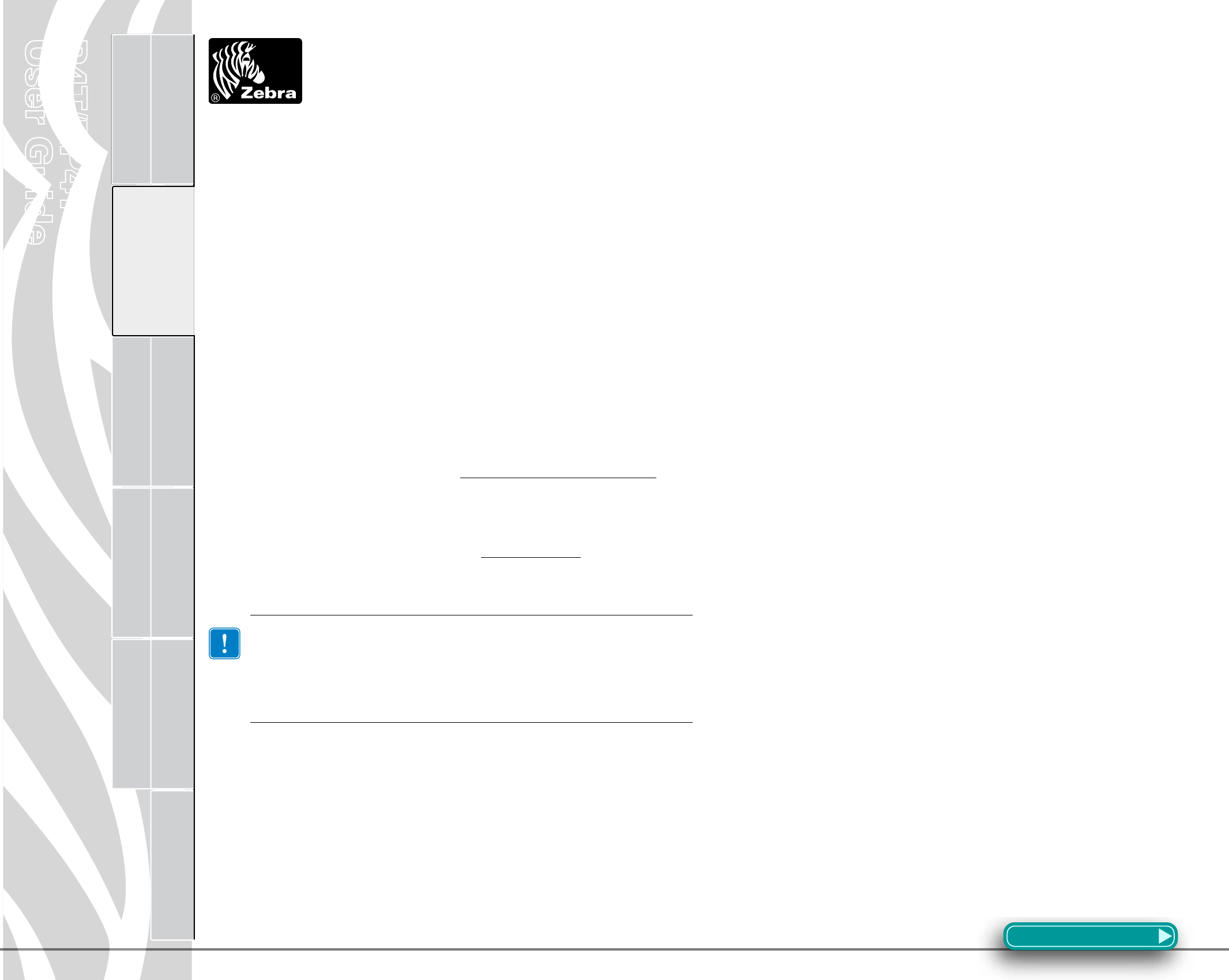
P4T/RP4T
User Guide
4
P4T Overview
Manual
Introduction Printer Preparation Connecting the
Printer
Radio Regulatory
Information
RP4T Printers Maintenance Troubleshooting Specifications Appendices Index
P4T
User Guide
4
Printer Preparation Connecting the
Printer
Radio Regulatory
Information
RP4T Printers Maintenance Troubleshooting Specifications Appendices Index
P4T Overview
Manual
Introduction
ThankyouforchoosingoneofourZebraP4TSeriesMobilePrint-
ers.TheP4TSeriesconsistsoftwomodels.TheP4T can print
on direct thermal or thermal transfer media. The RP4T can print
ondirectorthermaltransfermediaandalsoencodespecialRFID
media.
Because these printers are made by Zebra Technologies, you’re
assured of world-class support for all of your bar code printers,
software, and supplies.
•ThisUser’sGuidegivesyoutheinformationyou’llneedto
operateandmaintainboththeP4TandRP4Tmodels.
•P4TSeriesprintersusetheCPCLprogramminglanguage.To
createandprintreceiptsandlabelsusingtheCPCLlanguage,
refertoourLabelVista™labelcreationprogramortheMobile
PrintingSystemsCPCLProgrammingManualwhichareboth
available on our Web site at: www.zebra.com/manuals.
•P4TSeriesprintersoftwarealsoincludesinterpretersforthe
ZPLII®programminglanguage(uptoVersion30.8.4).Manuals
fortheZPLlabeldesignprogramminglanguagearealsoavail-
able on our Web site. Refer to Appendix“F” of this manual
for more information on accessing and downloading manuals
and other user information.
AlwaysrefertotheImportantSafetyInformationdatasheet
shippedwitheachprinterandtheTechnicalBulletinshipped
witheachbatterypack.Thesedocumentsdetailprocedures
toensuremaximumreliabilityandsafetywhileusingthis
printer.
Unpacking and Inspection
Inspect the printer for possible shipping damage:
•Checkallexteriorsurfacesfordamage.
•Openthemediacover(referto“LoadingtheMedia”inthe
PrinterPreparationsection)andinspectthemediacompart-
ment for damage.
Incasereturnshippingisrequired,savethecartonandallpack-
ing material.
Reporting Damage
If you discover shipping damage:
•Immediatelynotifyandleadamagereportwiththeshipping
company. Zebra Technologies Corporation is not responsible
for any damage incurred during shipment of the printer and
will not cover the repair of this damage under its warranty
policy.
•Keepthecartonandallpackingmaterialforinspection.
•NotifyyourauthorizedZebrare-seller.
Section Continues
Introduction to the P4T Series
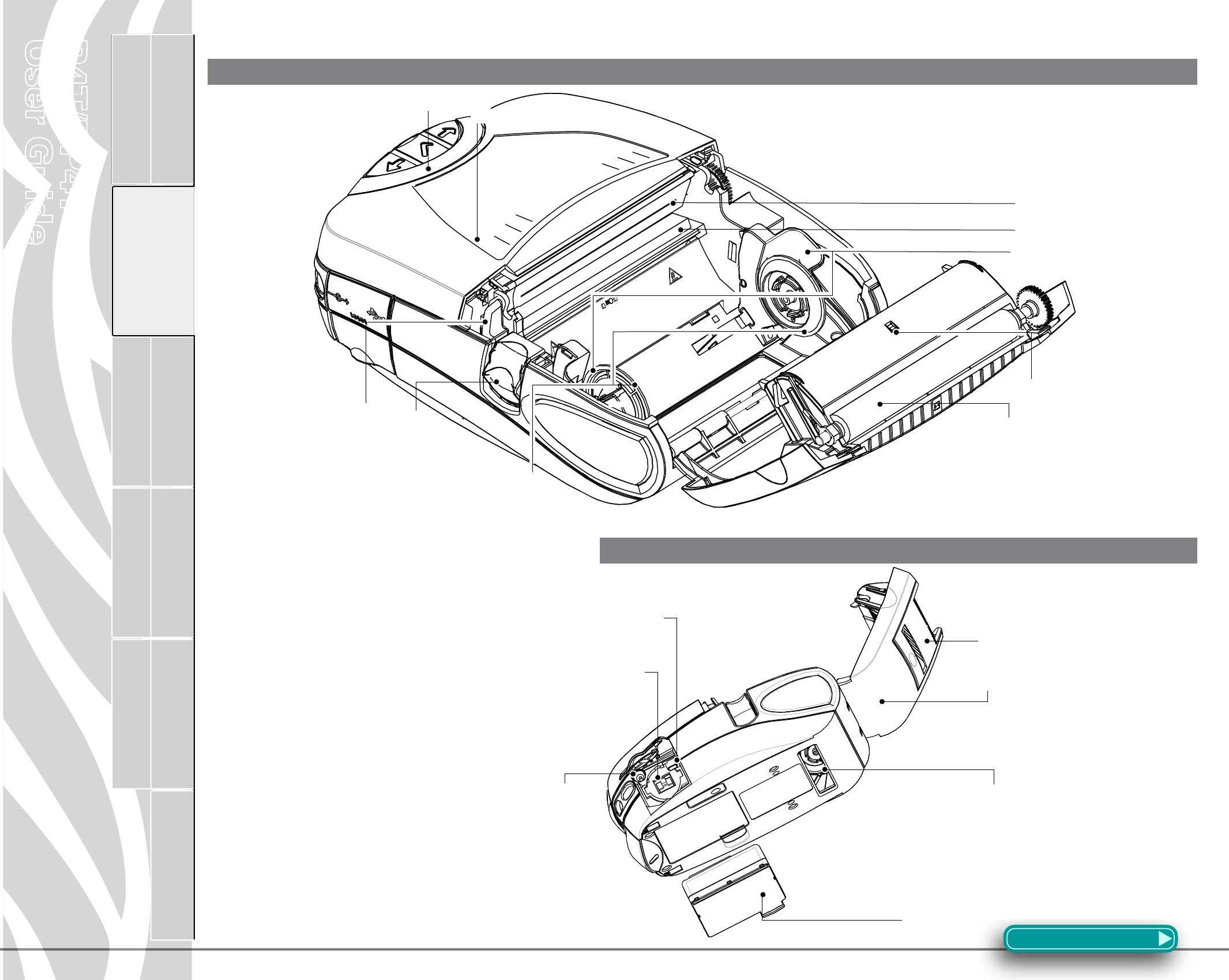
P4T/RP4T
User Guide
5
P4T Overview
Manual
Introduction Printer Preparation Connecting the
Printer
Radio Regulatory
Information
RP4T Printers Maintenance Troubleshooting Specifications Appendices Index
P4T
User Guide
5
Printer Preparation Connecting the
Printer
Radio Regulatory
Information
RP4T Printers Maintenance Troubleshooting Specifications Appendices Index
P4T Overview
Manual
Introduction
Figure 1a: P4T/RP4T Bottom View
Section Continues
P4T/RP4T Overview
Figure 1: P4T/RP4T Illustrated
1 Platen Roller
2. Bar Sensor
3. Media Support
4. Printhead
5. RFID Reader/Encoder (RP4T only)
6. Ribbon Cartridge Cover
7. Control Panel
8. Ribbon Cartridge Cover Latch
9. Media Cover Latch
10. Media Support Disks
11. Label Peeler
12. Media Cover
13. External Media Access (optional)
14. Battery
15. Battery Charging Receptacle
16. RS232 Communications Port
17. USB Port
17
14
15 13
1
2
8
76
9
16
4
11
12
10
5
3
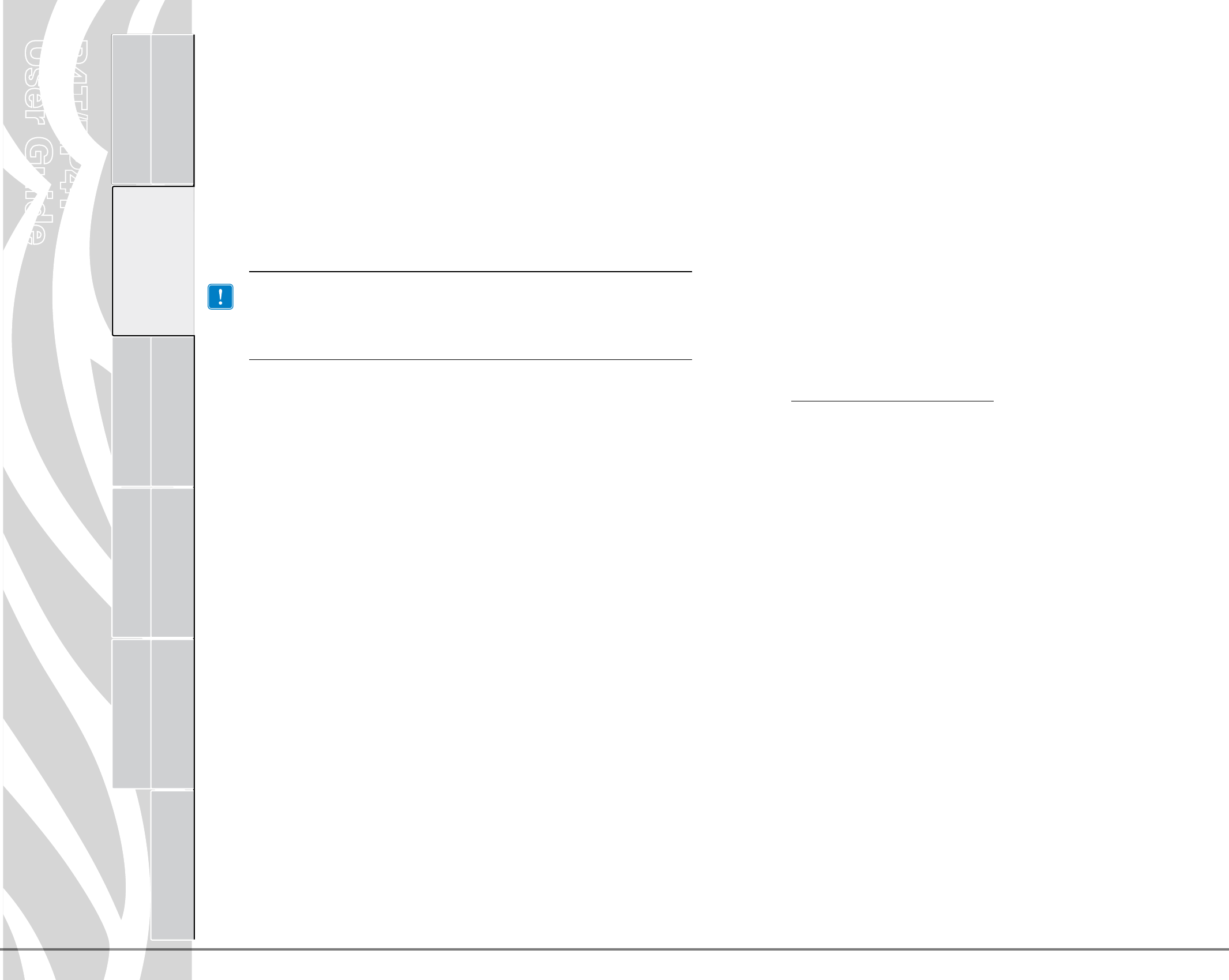
P4T/RP4T
User Guide
6
P4T Overview
Manual
Introduction Printer Preparation Connecting the
Printer
Radio Regulatory
Information
RP4T Printers Maintenance Troubleshooting Specifications Appendices Index
P4T
User Guide
6
Printer Preparation Connecting the
Printer
Radio Regulatory
Information
RP4T Printers Maintenance Troubleshooting Specifications Appendices Index
P4T Overview
Manual
Introduction
TheP4TSeriesintroducesseveralnewtechnologiestotheZebra
Mobile Printer product line.
Smart Battery
TheP4TSeriesbatterypackcontainselectronicswhichallowthe
printer to monitor its operating parameters. Among these are the
battery’s charge state, the number of charge cycles it has under-
gone, and its date of manufacture. Using these parameters, the
P4TSeries’softwarecanmonitorthebattery’sconditionandalert
the user when to recharge, re-condition or remove the battery from
service.
Useofanybatterypackotherthantheonemanufacturedby
ZebraspecicallyforusewithP4TSeriesprinterswillnot
beabletousethediagnosticfeaturesoftheZebraSmart
Batteryandwillnotworkwiththeprinter.
Printing Technology
TheP4TSeriesusestwomethodstoprinthumanreadibletext,
graphicsandbarcodes:DirectThermal,andThermalTransfer
DirectThermal
Directthermalprintingusesheattocauseachemicalreactionon
speciallytreatedmedia.Thisreactioncreatesadarkmarkwher-
ever a heated element on the printhead comes in contact with the
media. Since the printing elements are arranged very densely at
203d.p.i.(dotsperinch)or8dotspermm,highlylegiblecharacters
and graphic elements may be created a row at a time as the media
is advanced past the printhead. This technology has the advantage
of simplicity, as there is no requirement for consumable supplies
suchasinkortoner.However,sincethemediaissensitivetoheat,
it will gradually loose legibility over long periods of time, especially
if exposed to environments with relatively high temperatures.
ThermalTransfer
Thermal transfer printing uses the same basic technology as direct
thermal, except that the printhead elements react with a transfer
film which passes between the printhead and the media. The print-
ing process fuses the thermal transfer material to the media being
printed and creates characters and graphic images that are very
dark,andmorepermanentthanthosecreatedbydirectthermal
printing. Offsetting this advantage is the extra cost of the thermal
transfer film and printing speeds slower than those required for
direct thermal printing.
Foreaseofinstallation,P4TSeriesthermaltransferlmissupplied
as a cartridge. Typically a thermal transfer film cartridge will be
able to print two rolls of media before needing replacement. This
ratiomayvaryconsiderablybasedontheamountoflabelstock
per roll.
RFID (Radio Frequency Identification)
AP4TSeriesprinterequippedwithanRFIDencoderallowsitto
encode information on special label media using radio frequen-
cies in addition to using conventional thermal transfer technology.
These printers are identified as RP4Tprinters.
RFIDencodedinformationcanberetrievedusinganRFIDscanner
from a distance of inches to several yards from an encoded label.
Zebra’simplementationof RFIDfollows acceptedindustrystan-
dards.Asanexample,theRP4Tveriestheinformationencoded
on the label media after it is transmitted and voids the label if the
dataisincorrect.MoreinformationconcerningRFIDmaybefound
in Zebra’s RFIDProgrammingManual, available for download on
Zebra’s Web site.
P4T Series Technology
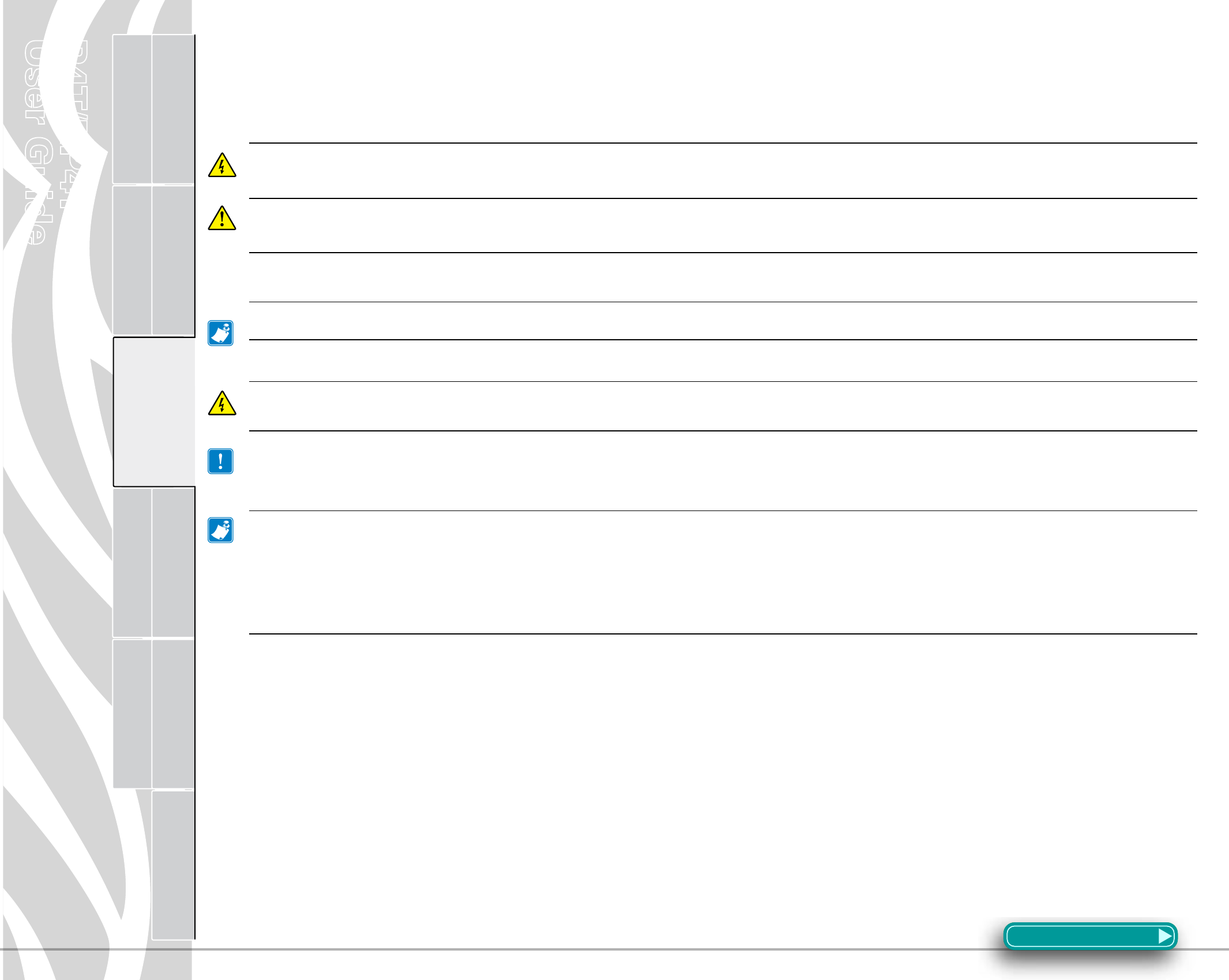
P4T/RP4T
User Guide
7
Printer Preparation Connecting the
Printer
Radio Regulatory
Information
RP4T Printers Maintenance Troubleshooting Specifications Appendices Index
P4T Overview
Manual
Introduction
Printer Preparation
Battery Safety
TheBatteryPacksusedonZebraMobilePrinterscontainagreatdealofenergyandcancausepersonalinjuryorstartareifused
improperly or carelessly. Please observe the following safety practices:
Caution• Avoidaccidentalshortcircuitingofanybattery. Allowingbattery terminalstocontactconductivematerialwill
createashortcircuitwhichcouldcauseburnsandotherinjuriesorcouldstartare.
Caution•Batteriescanexplodeorcatchreifimproperlychargedorexposedtohightemperaturesorre.Donotdisassemble,
crushorexposebatteriestowater.
Caution•UseofanychargernotapprovedspecicallybyZebraforusewithitsbatteriescouldcausedamagetothebattery
packortheprinterandwillvoidthewarranty.
ReadcarefullyandalwaysobservethesafetyguidelinesforLi-ionbatteriesprovidedwitheachBatteryPack.
Charger Safety
Donotplaceachargerinlocationswhereliquidsormetallicobjectsmaybedroppedonthechargeror,inthecaseofthe
UCLI72-4QuadCharger,intothechargingbays.
UsecareinlocatinganyoftheapprovedP4TSeriessinglechargers,theACAdapterortheUCLI72-4QuadCharger.Donot
blocktheventilatingslotsonthetopandbottomcovers.EnsurethattheChargerispluggedintoapowersourcewhichwon’t
accidentlybeturnedoffifyouwillbechargingbatteriesovernight.
RequiredRegulatoryTextforArgentina
Onlycertiedadaptorswiththefollowingelectricalcharacteristicsshallbeused.Theuseofdifferentadaptorscoulddamage
thedevice,presenthazardstotheuseranddeclarethecorrespondentguarantyvoid.
LI72:Inputratings:100-240VAC50/60Hz200mA.,Class2
Outputratings:8.4VDC,800mA
Section Continues
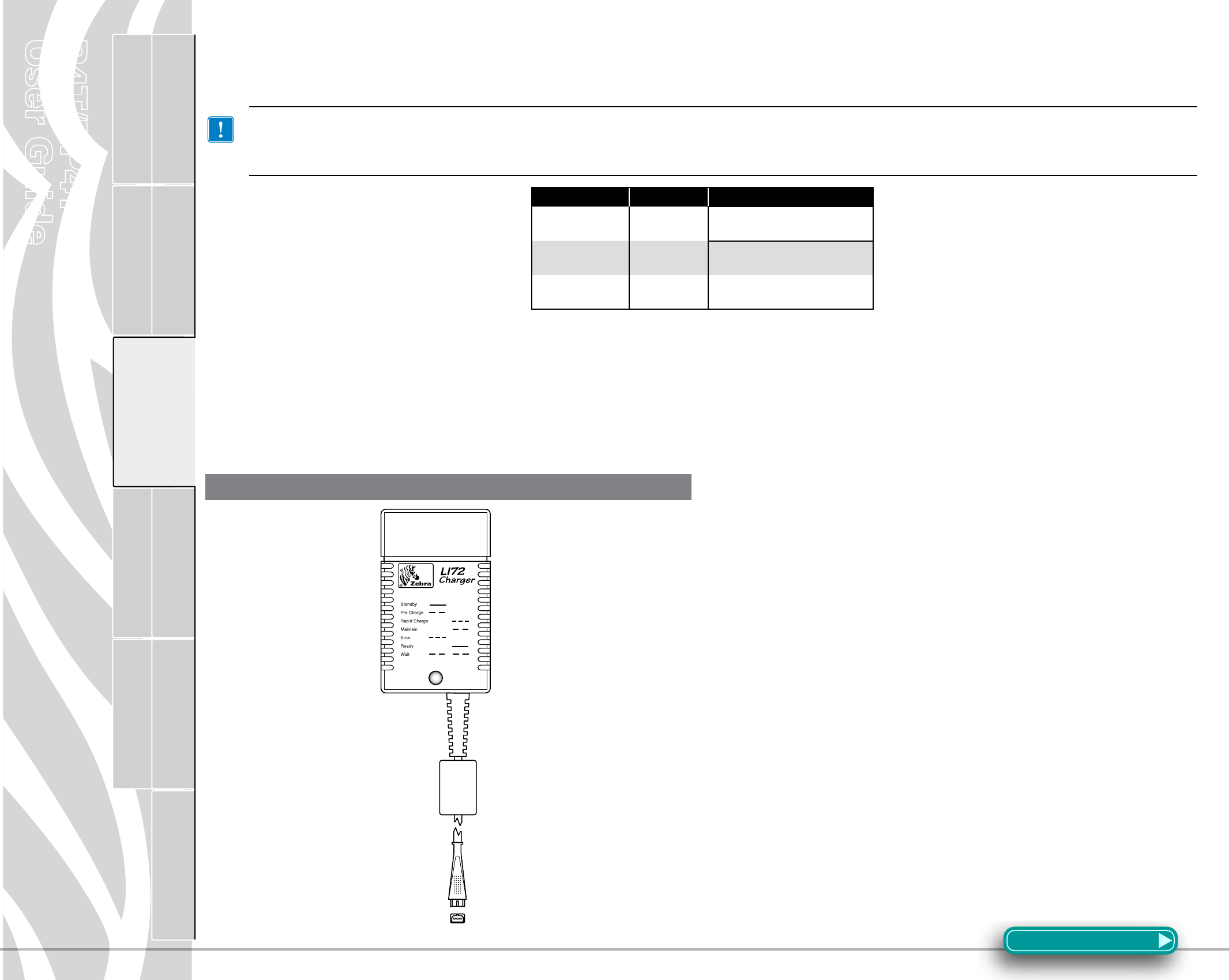
P4T/RP4T
User Guide
8
Printer Preparation Connecting the
Printer
Radio Regulatory
Information
RP4T Printers Maintenance Troubleshooting Specifications Appendices Index
P4T Overview
Manual
Introduction
Section Continues
Approved Chargers
ThefollowingtablelistsbatterychargersapprovedforusewiththeP4TSeriesPrinter.
UseofchargersnotapprovedbyZebraspecicallyforusewiththeP4TSerieswillvoidthewarrantyandcouldcausedamage
totheprinterorthebattery pack.Zebraisnotresponsibleforanydamagetoequipmentcausedbytheimproperuse of
unauthorizedequipment.
Description Part no Notes.
LI72 single
charger) AT17696-xx1Must be used with battery
removed from printer
AC Adapter/US
Line Cord AK18913-002 Must be used with battery
installed in printer
UCLI72-4 Quad
Charger AC18177-xx1Must be used with battery
removed from printer
1. Full part number is determined by the AC mains adapter ap-
propriate for the region of intended use. Consult your Zebra
sales representative or the factory for the appropriate part num-
ber.
Single Battery Charger
The LI72 Charger
LI72chargerisawallmountedfastchargerwithauniversal110to
230,50-60Hz.VACinput.MultipleACplugcongurationscomply
with most international standards. This charger is intended for use
withtheP4TSeriesprinterswhichareequippedwithLithiumIon
(Li-ion)batteries.
Full part numbers are determined by the AC mains connectors.
Consult Zebra or your authorized re-seller for full part number in-
formation.
TheLI72willchargeabatterypackasfastasitschargelevelwill
allow,andthenswitchovertoamaintenancechargetokeepthe
charge at its maximum.
Ye llow Green
Figure 2: LI72 Single Charger
LI72 Charger
AT17696 -tab
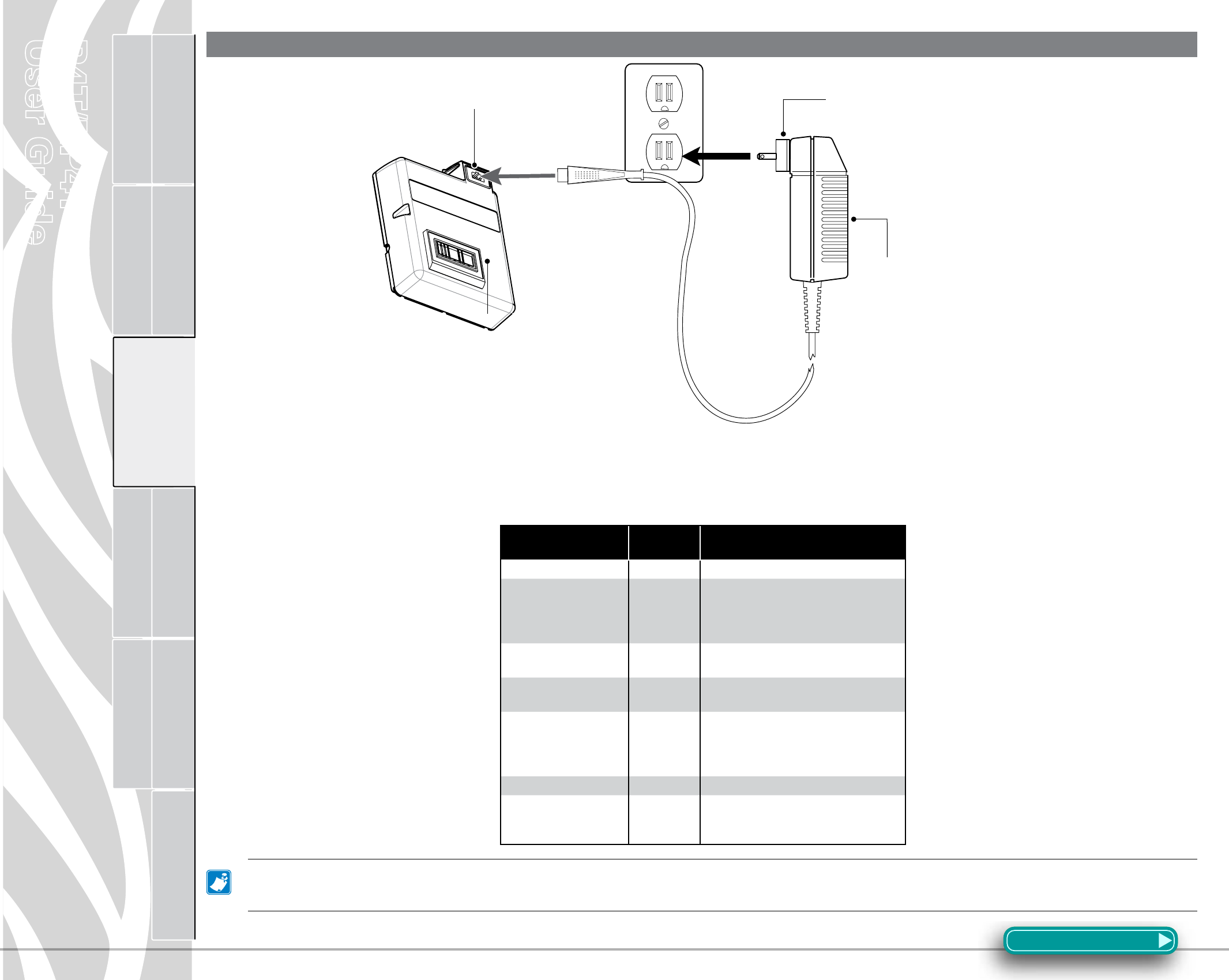
P4T/RP4T
User Guide
9
Printer Preparation Connecting the
Printer
Radio Regulatory
Information
RP4T Printers Maintenance Troubleshooting Specifications Appendices Index
P4T Overview
Manual
Introduction
Charging Battery Packs with the AT17696-xx LI72 Single Charger
PlugtheLI72intotheappropriateACwallreceptacle,theninsertthechargecableintothebatterypackchargerjack.
Theyellow/greenchargeindicatorLEDwillindicatethestatusofthechargerasperthefollowingtable.
Indicator Charger
Function Charger Status
Steady yellow indicator Standby AC power on; no battery being charged
Slow (1 Hz) flashing
yellow indicator Pre-Charge
Charger is applying trickle charge current
(5% of maximum) to bring a cold battery
temperature up to 0°C before starting a
full charge cycle
Fast (4 Hz) flashing
green indicator
Rapid
Charge
Charger is applying the maximum charge
rate to the battery
Slow (1 Hz) flashing
green indicator Maintain Charger is in trickle charge mode(10% of
nominal charge value).
Fast (4 Hz) flashing
yellow indicator Error
The battery may have an internal short,
or its charge monitoring circuitry may be
malfunctioning. The battery pack should
not be used any further.
Steady green indicator Ready No charge is being applied to the battery
Slow (1 Hz) flashing
alternate yellow and
green indicator
Wait
Battery temperature is too hot. Charging
will not begin until battery temperature
reaches 45°C.
Notes:ThebatterypackmustberemovedfromtheprinterwhenusingtheAT17696-xxLI72SingleCharger.
Chargingwillceasethree(3)hoursafterthechargerhasenteredthe“Maintain”mode.
Figure 3: Charging the P4T Series Battery with the LI72
Section Continues
P4T Series
Battery Pack
LI72 Battery
Charger
Battery Charging
Receptacle Mains connector will
vary with country of
intended use.
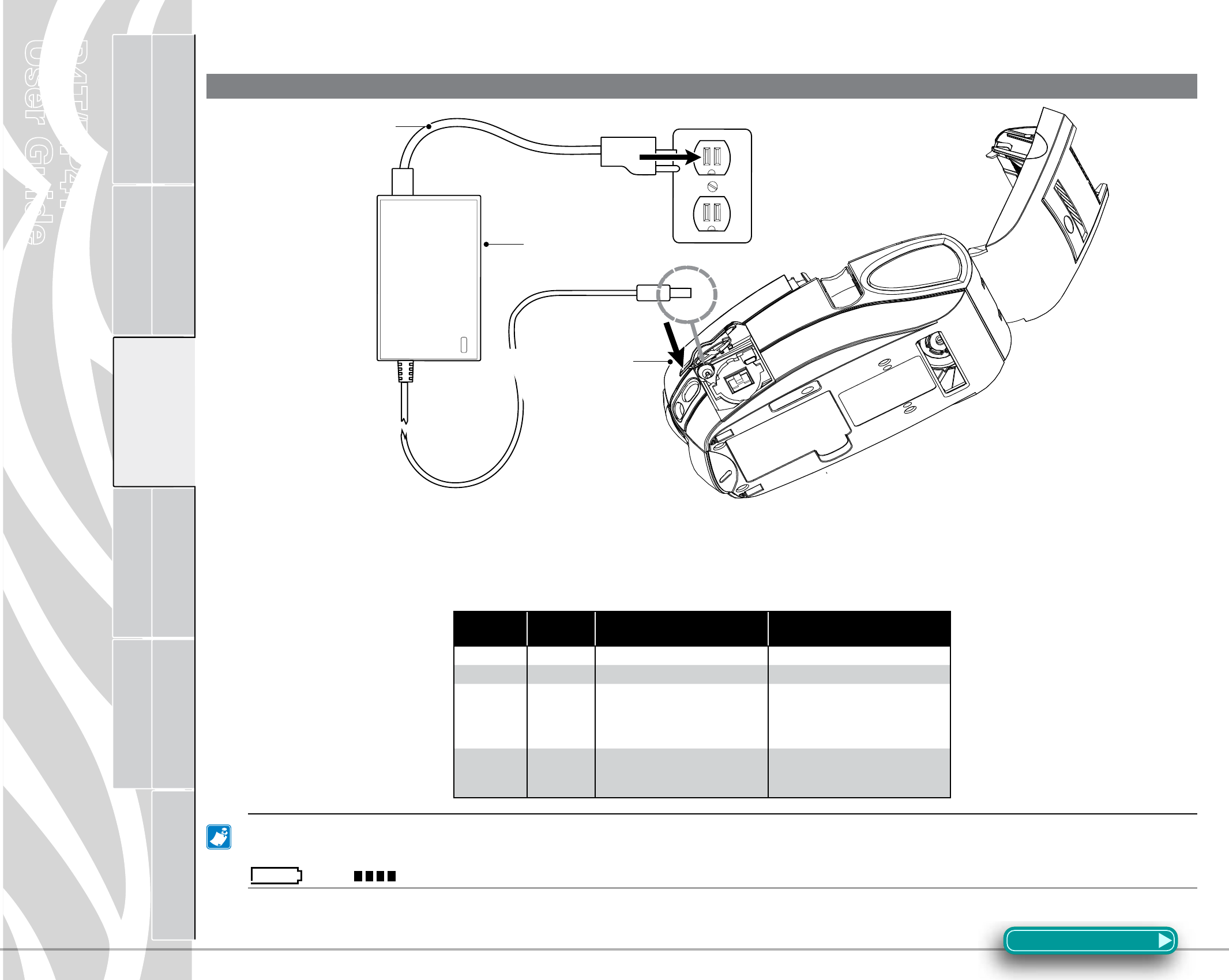
P4T/RP4T
User Guide
10
Printer Preparation Connecting the
Printer
Radio Regulatory
Information
RP4T Printers Maintenance Troubleshooting Specifications Appendices Index
P4T Overview
Manual
Introduction
Charging the P4T Series Battery with the AT18646-1 AC Adapter
Figure 4: Charging the P4T Series Battery with the AC Adapter
Section Continues
• OpentheprotectivecoverontheP4TSeriesprintertoexposethechargerjackandthecommunicationports.
• PlugthebarrelplugfromtheAT18646-1ACadapterintothechargerjackontheprinter.
• ConnecttheappropriateACpowercordforyourlocationtotheadapterandthenplugthepowercordintoanACreceptacle.
ThefollowingtabledetailshowtheACAdapterandP4TSeriesprintersinteract:
Printer
Status
Charging
Status
Printer LCD Power Button Operation
Off Off Off Pressing turns printer On
On Off Normal display operation Pressing turns printer Off
On On
Normal display operation, plus
battery icon will cycle through
level bars. Charging will continue
as required..
Pressing switches printer to limited
operation: only battery charging &
LCD functional
Off On
Battery icon will cycle through
level bars. Printer turns off at end
of charge cycle.
Pressing turns printer On. Printer
will run normally
Note:Ifthebatteryisoutofitssafechargingtemperaturerange(eithertoohotortoocold)theprinterwilldisplaythefollowing:
“Chargingwillresumewhenbatteryisintherange0-40degreesC(32-104degreesF)”andthebatteryiconwillalternatelyash
and .Oncethebatteryreachesasafechargingtemperature,normalchargingwillautomaticallyresume.
P4T Series AC
Adapter
p/n AT18646-1
Open the
protective cover
for access to
the charger
receptacle
AC Power Cord
(varies with
location)
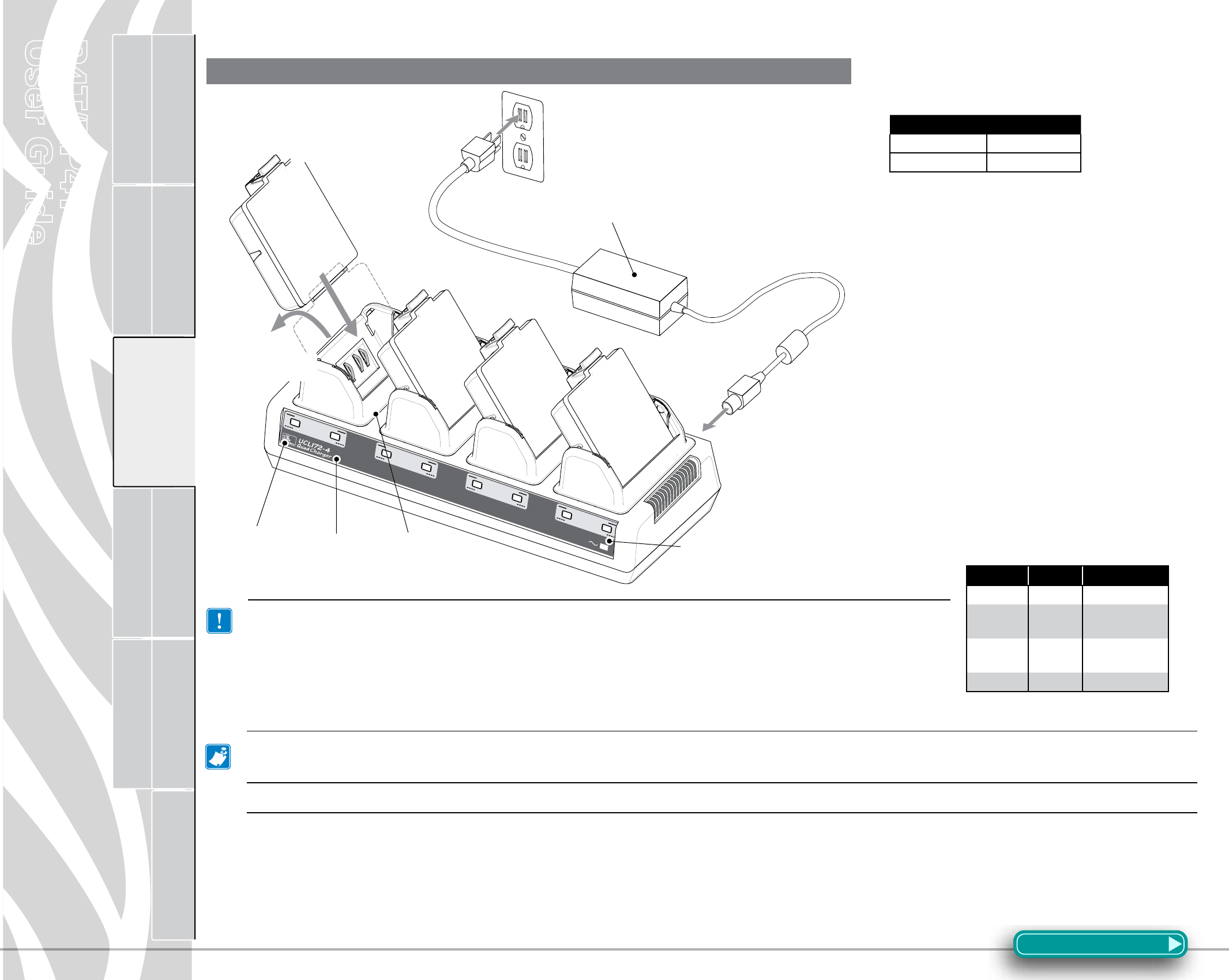
P4T/RP4T
User Guide
11
Printer Preparation Connecting the
Printer
Radio Regulatory
Information
RP4T Printers Maintenance Troubleshooting Specifications Appendices Index
P4T Overview
Manual
Introduction
Charging the P4T Series Battery with the UCLI72-4 Quad Charger
The UCLI72-4QuadChargerisdesignedto
chargeuptofourbatterypackssimultane-
ously. Charging times are as follows:
Battery Status Charging Time
80% charged 2.5 Hrs.
Full charge 5 Hrs.
•Ensurethatthechargerhasbeeninstalled
properlypertheQuadChargerinstruction
manual. Ensure that the power indicator on
the front panel is on.
•Removeanyprotectiveshrink-wrapand
labelsfromallbatterypackspriortorstuse.
Plugabatterypackintoanyoneofthefour
charging bays as shown opposite in Figure _,
notingtheorientationofthebatterypack.
• Slide the battery pack into the charging
bay until it stops.
•Rockthebatterypackbackuntilitsnaps
into place.
The amber indicator directly under the bat-
tery being charged will turn on if the battery
is properly inserted.
The indicators under each battery will allow
you to monitor the charging process per the
table below:
Amber Green Battery Status
On Off Charging
On Flashing 80% charged
(O.K. to use)
Off On Completely
Charged
Flashing Off Faulty Battery
Section Continues
Important•Afaultcondition(ashingamberindicator)iscausedbyaproblemwiththebattery
pack.Thechargermayindicateafaultbecausethebatteryistoohotortoocoldtocharge
reliably.Trytochargethebatteryagainwhenitreturnstotheroom’sambienttemperature.
If the amber indicator starts ashing onthe second charging attempt, the battery should
bediscarded.Alwaysdisposeofbatteriesinapropermanner.RefertoAppendixEofthis
manual.
Fault
Fast Charge
Fault
Fast Charge
Fault
Fast Charge
Ready
Power
Full Charge
Ready
Full Charge
Ready
Full Charge
Full Charge
Fault
Fast Charge
Ready
Figure 5- UCLI72-4 Quad Charger
Notes:FormoreinformationregardingtheinstallationanduseoftheUCLI72-4QuadChargerrefertotheinstructionsincluded
withtheproduct.
TheUCLI72-4QuadChargerhasasafetyfeaturewhichstopschargingabatteryaftersixhoursregardlessofitschargestate.
Charger
Bay
Amber
Indicator
Green
Indicator Power Indicator
Power Supply
Slide Battery Pack
into a Charger bay
Rock Battery
Pack into place
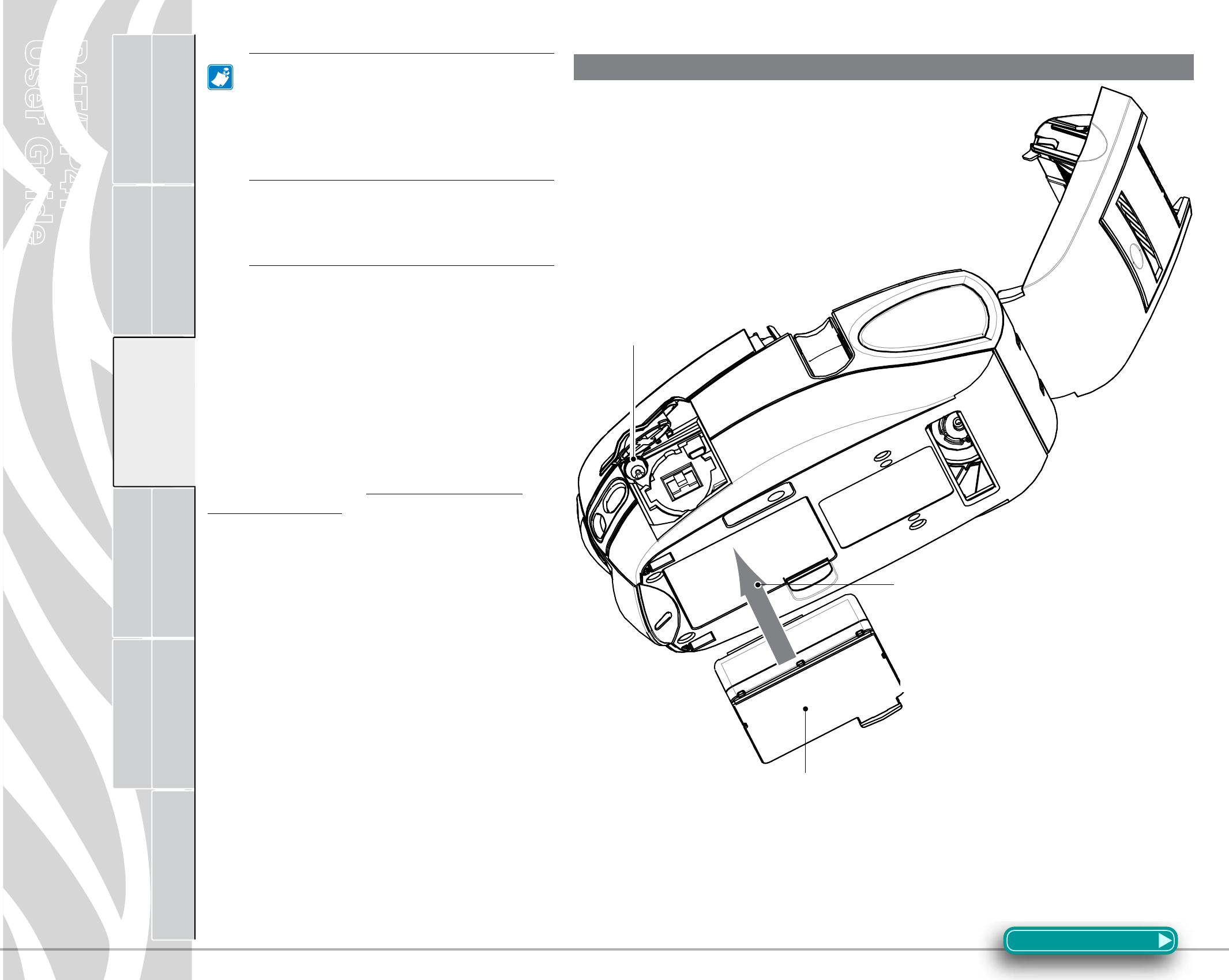
P4T/RP4T
User Guide
12
Printer Preparation Connecting the
Printer
Radio Regulatory
Information
RP4T Printers Maintenance Troubleshooting Specifications Appendices Index
P4T Overview
Manual
Introduction
Installing the P4T Series Battery Pack
Important•Newbatterypacksareshipped
uncharged.Removeanyprotecti veshrink-
wrapandlabelsfromanewbatterypack
priortouse.
Additionalbatterypacksmaybeordered
usingZebrap/nAK18913-001.
If you are using an LI72 single charger
or the LI72-4 Quad Charger, you must
chargethebatterypriortoinstallingitin
theprinter.
•.Insertthebatterypackintotheprinteras
showninFigure6.
•Rockthe battery packinto theprinter as
shownuntilitlocksinplace.
If you are using the AC adapter, you should
allowthebatterypacktochargecompletely
prior to using it for the first time.
Whenanewbatterypackisrstinstalled,the
Control Panel indicators may briefly turn on and
then go off, indicating the battery is not fully
charged. Refer to the ChargingtheBattery and
OperatorControls topics in this manual.
Figure 6: Installing the P4T Series Battery Pack
Section Continues
P4T Series
Battery Pack
Insert this side of the
battery pack into the
bottom of the printer as
shown.
Rock the battery pack
until it clicks into place.
Charger port
for use with the
AT18646-1 AC
Adapter
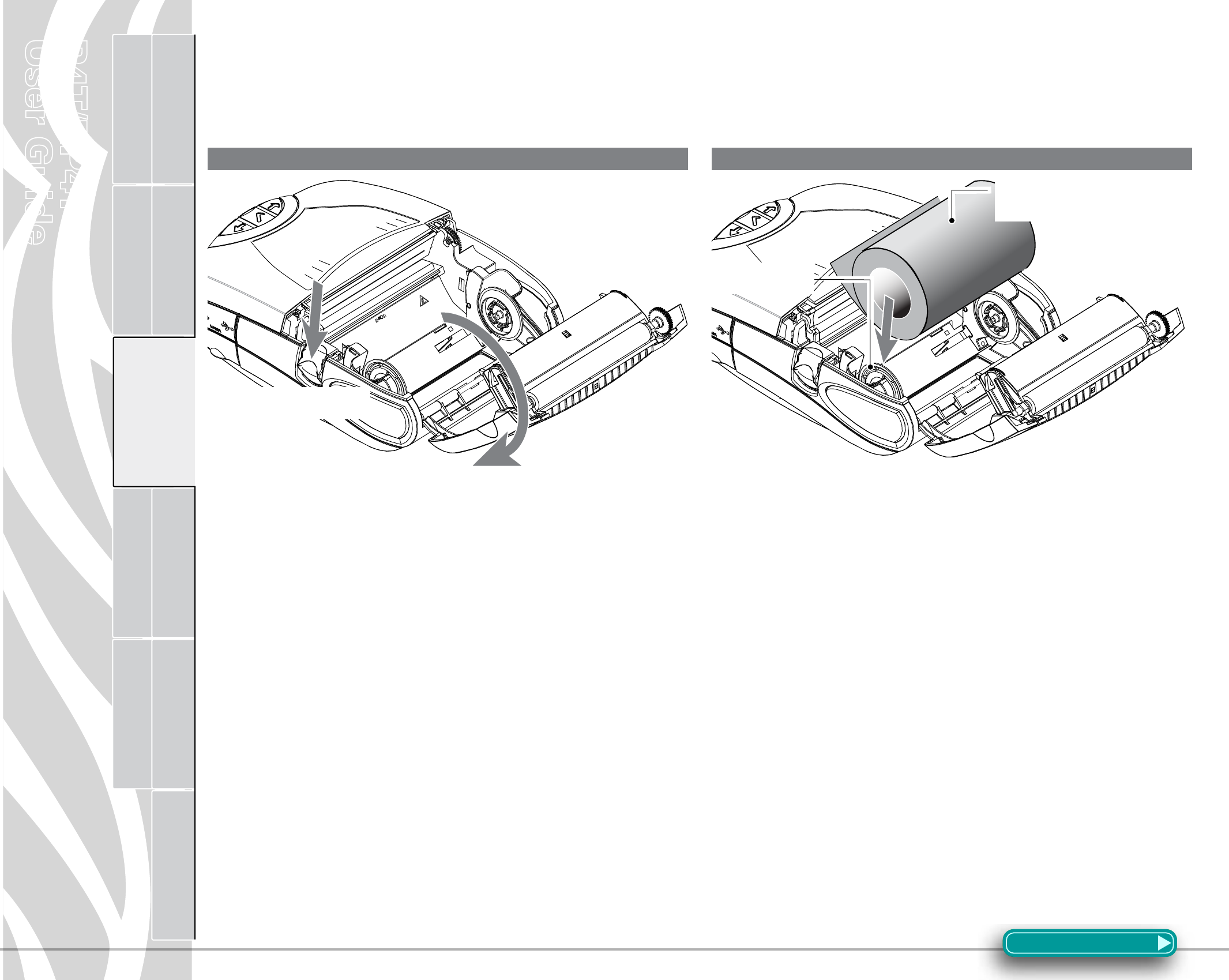
P4T/RP4T
User Guide
13
Printer Preparation Connecting the
Printer
Radio Regulatory
Information
RP4T Printers Maintenance Troubleshooting Specifications Appendices Index
P4T Overview
Manual
Introduction
Load the Media
Section Continues
P4Tseriesprintersaredesignedtoprinteithercontinuous(journal)
mediaorlabelstock.
1. Open the Media Cover
RefertoFigure7.1.
•Press thelatchreleasebuttononthesideoftheprinteras
shown at “1” below. The media cover will open automati-
cally
•RotatetheMediaCoverbackcompletelyasshownexposing
the media compartment and the adjustable media supports.
2. Loading Media From An Internal Supply
RefertoFigure7.2.
•Pullthemediasupportsapartasshown.
•Inserttherollofmediabetweenthem,andletthemediasup-
ports close. Ensure that the media pulls off the core in the
directionshowninFigures7.2and7.4.Thesupportswillcenter
the media roll within the media compartment, and the media
roll should be able to spin freely on the supports.
Figure 7.1 Opening the Media Cover Figure 7.2 Loading the Media
Press down on the Media
Cover Latch Lever
Pull Media Supports
apart where shown.
Load Media Roll
Note direction media
pulls off the roll.
Media cover opens
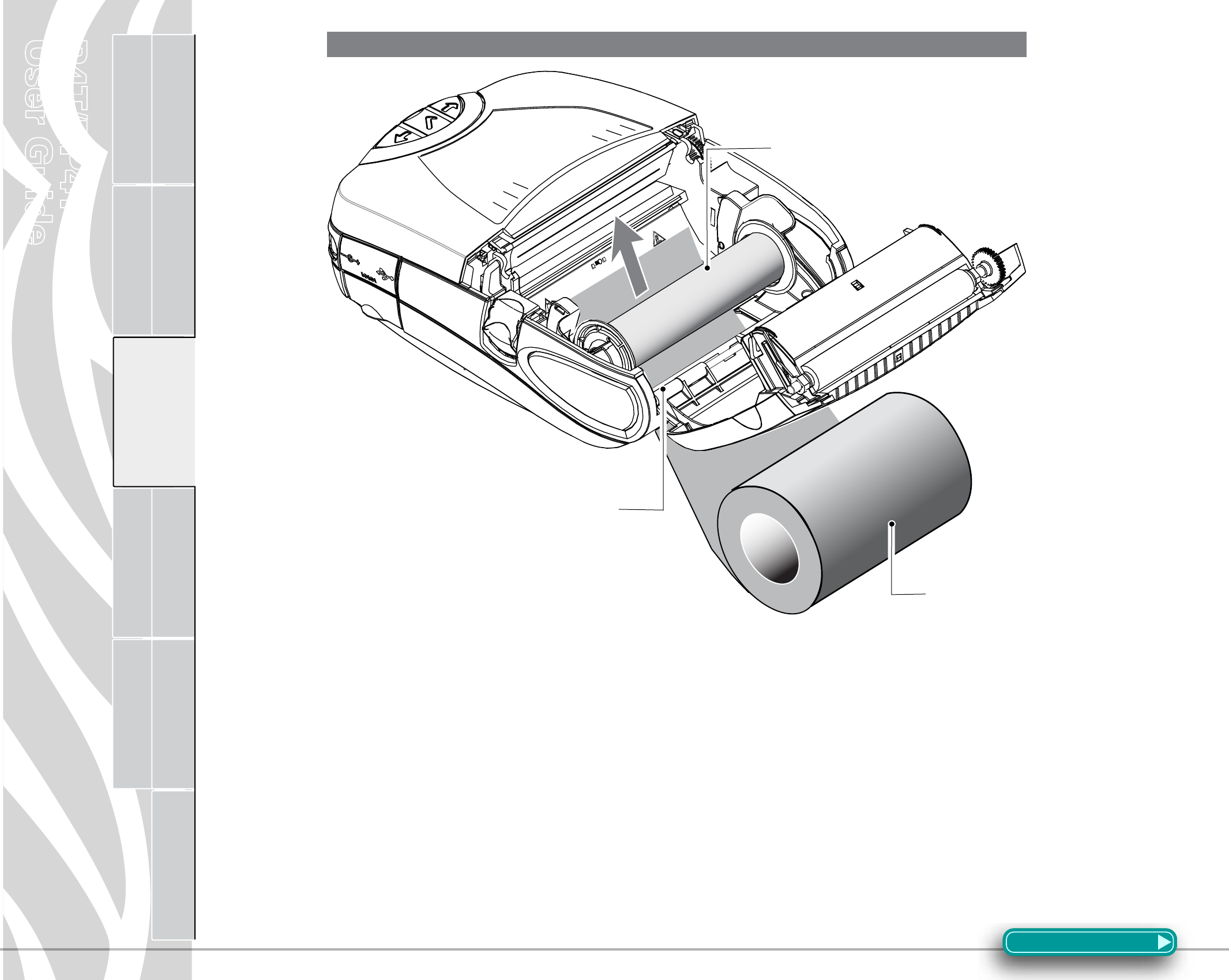
P4T/RP4T
User Guide
14
Printer Preparation Connecting the
Printer
Radio Regulatory
Information
RP4T Printers Maintenance Troubleshooting Specifications Appendices Index
P4T Overview
Manual
Introduction
Figure 7.3- Loading Media From An External Supply
Section Continues
3. Loading Media From An External Supply
RefertoFigure7.3.AP4TSeriesprinterconguredwiththeExternalMedia
option has a loading slot in the rear of the media compartment allowing you to
use4.0in.(101.6mm)widefanfoldorrollmediafromanexternalsupply.The
external supply must be designed such that it does not exert excessive drag as
media is fed through the printer, which could result in distorted printing.
•Pullthemediasupportsapart,insertaMediaSpacer(Zebrapartnumber
BA16625-1)betweenthem,andletthemediasupportsclose.
•Insertthemediafromtheexternalsupplythroughtherearfeedslot,between
themediaguidesandupthroughthemediacompartmentasshown.Make
sure the side of the media you will be printing on faces the printhead.
Rear Feed Slot
Media Spacer
External Media
Source
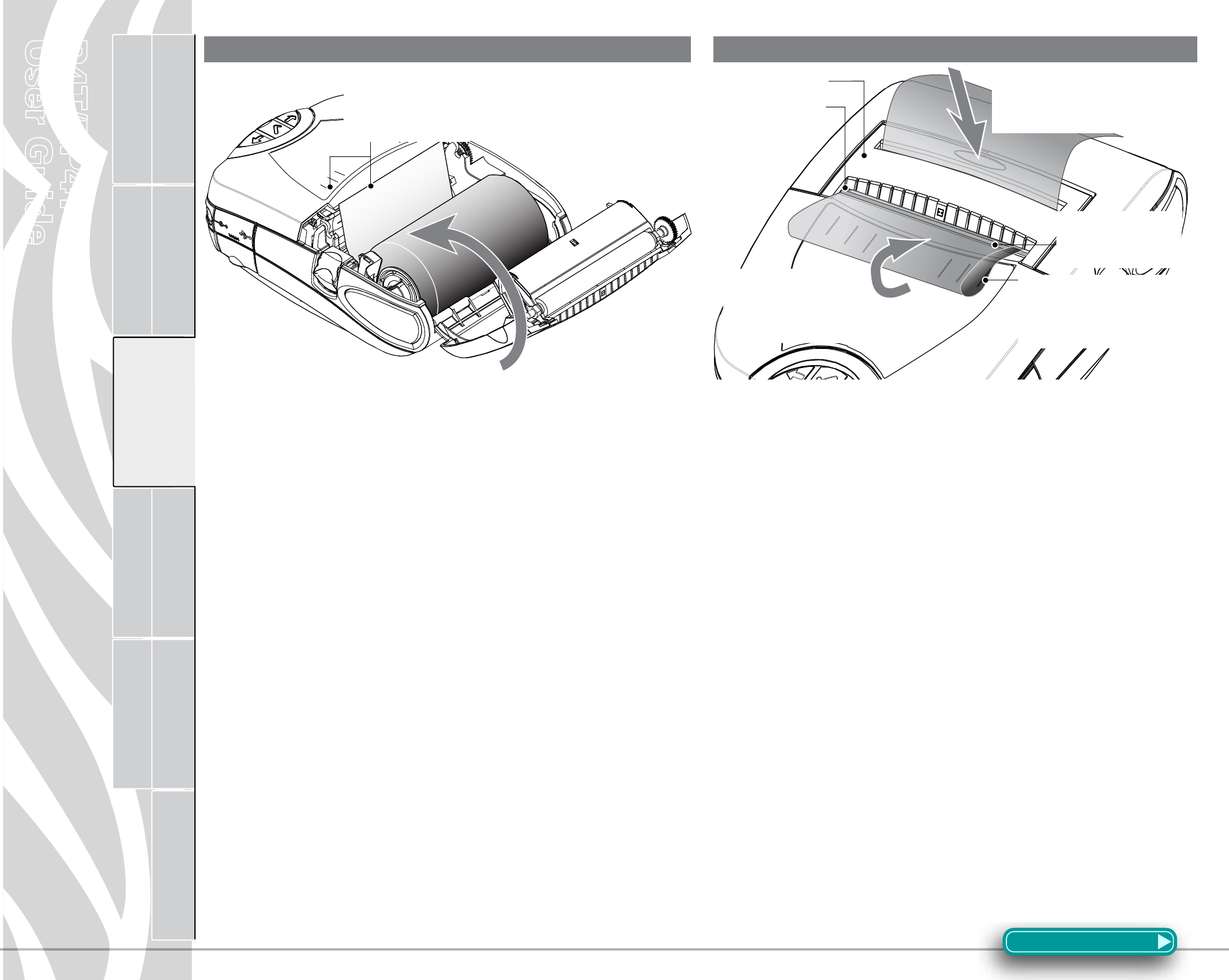
P4T/RP4T
User Guide
15
Printer Preparation Connecting the
Printer
Radio Regulatory
Information
RP4T Printers Maintenance Troubleshooting Specifications Appendices Index
P4T Overview
Manual
Introduction
Figure 7.4-Close the Media Cover Figure 7.5- Insert Media into Peeler
Section Continues
4. Close the Media Cover:
RefertoFigure7.4.
•Pullthemediaoutoftheprinterasshownat“1.”
•Closethemediacoverasshownat“2”,ensuringthatitlatches
securely into place.
•TurntheprinteronorpresstheFeedbuttoniftheprinteris
already on.
•Theprinterwilladvanceashortstripofmediaandwillthen
be ready for printing.
5. Using the Label Peeler
Optional Step for label stock only
RefertoFigure7.5.
The label peeler feature allows automatic separation of the printed
labelfromitsbacking.
1.Ifyouwishtousethelabelpeelingfeature,removeenough
labelsfromthemediarolltocreatealeaderapproximately4”
[100mm.]long.
2.Alignthemediaasitemergesfromtheprintheadwiththe
indexmarksonthetopcovertoensureitwillpassthrough
thepeelerassemblywithoutwrinkling.
2.Feedtheleaderyoucreatedinstep1overthepeelerbarand
into the peeler assembly.
3Push on the peeler assembly where shown in Figure 6.5.
Insert the leader into the label peeler as shown and push on
the media roll until it emerges from the slot at the rear of the
peeler assembly.
•TurntheprinteronorpresstheFeedbuttoniftheprinteris
already on.
•Theprinterwilladvanceashortstripofmediaandwillthen
be ready for printing.
Close Media
Cover
3. Feed the leader over
the peeler bar and into
the printer if you will be
peeling labels as you
print.
4. Press down on Peeler
Assembly where shown
and slide the media until it
emerges .
Peeler Bar.
2. Align the edge of the
leader with the index marks
on the top cover to ensure it
will pass through the peeler
without wrinkling.
Peeler Assembly.
Pull Media out of the
Printer. Use alignment
marks on the cover to
ensure alignment.
1. Remove enough
labels from the media
roll to create a 4” [100
mm] leader.
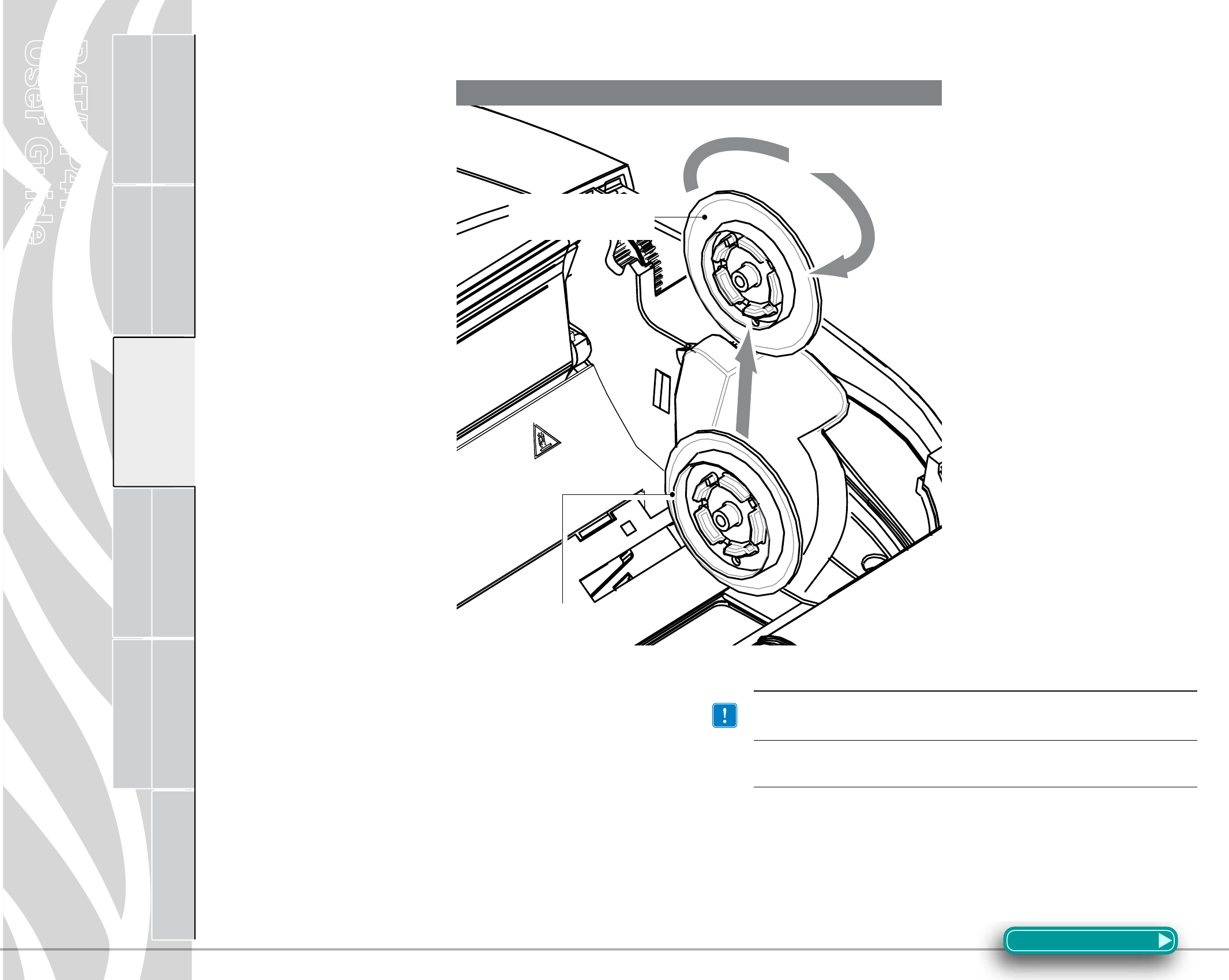
P4T/RP4T
User Guide
16
Printer Preparation Connecting the
Printer
Radio Regulatory
Information
RP4T Printers Maintenance Troubleshooting Specifications Appendices Index
P4T Overview
Manual
Introduction
Adjusting The Media Support Disks
Media Core Size
MediasuppliedfortheP4TSe-
ries printers will have two pos-
sible core sizes, depending on
the media type. Journal media
and most label media is supplied
witha0.75”[19.1mm]diameter
core to maximize the amount of
media contained on a roll.
P4Tprintermediasupportsare
setatthefactoryfor0.75”diam-
eter media cores.
RP4T printers (equipped with
theRFIDencoder)arecongured
formediawith1.38”[35.05mm]
diametercoressinceRFIDme-
dia cannot be wound around
a small diameter core without
both degrading its ability to feed
properly past the printhead and
causing possible damage to the
embeddedRFIDcircuitry.
Changing The Media Support
Core Diameter Size
It may become necessary to
change the media core size in
the field to allow use of different
media.
The media support disks are
designed for both sizes of media
cores, and they can be adjusted
by removing them, flipping their
position and re-securing them to
the printer.
1. Open the Media Cover and
remove any label media.
2.UsePhillipsheadscrewdriver
with a long blade to keep the
screwattachingtheSupportDisk
to the printer from turning.
3.RotatetheSupportDiskwhile
keeping the attachment screw
from turning, and remove it.
4. Flip the Media Support Disk
so that the desired core diameter
ridge faces towards the inside of
theprinter.PleaserefertoFigure8.
5.Re-securetheSupportDiskbytighten-
ingitontotheattachingscrew.Donotover
tightentheSupportDisk.Itmustbeabletospin
freely.
RepeatthisprocedureontheotherSupportDisk.
AlwaysensurethatbothSupportDisksareadjustedforthe
samesizemediacore.
ReplacetheMediaSupportDisksiftheyhavebeenadjusted
fordifferentcoresizesmorethan5(ve)times.
Figure 8- Adjusting the Media Core Diameter
Section Continues
Media Support Disk
(shown adjusted for 1 3/8”
label media core)
Media Support Disk
(shown re-adjusted for
3/4” label media core)
Remove Support Disk,
and flip it 180° to change
core size.
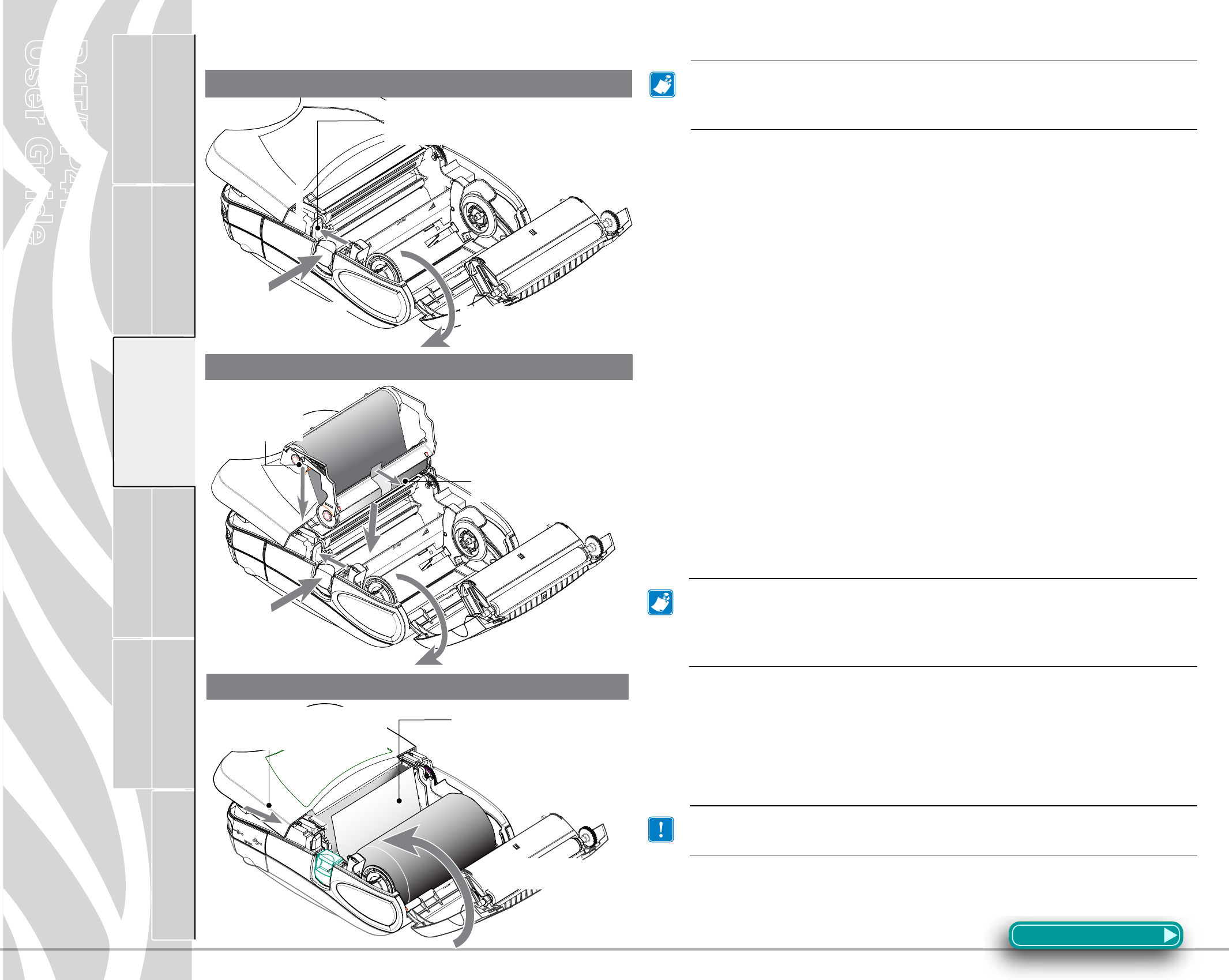
P4T/RP4T
User Guide
17
Printer Preparation Connecting the
Printer
Radio Regulatory
Information
RP4T Printers Maintenance Troubleshooting Specifications Appendices Index
P4T Overview
Manual
Introduction
Load the Ribbon Cartridge
Section Continues
IfyouareusingmediathatrequiresThermalTransfermedia,perform
thisstep.Ifyouareusingjournalstock,ormediathatusesdirect
thermaltechnologytoprintlabels,omitthisstep.
1. Open the Printer Covers
RefertoFigure9.1.
•Pressthelatchreleasebuttononthesideoftheprinterasshownat
“1”ingure9.1.Themediacoverwillopenautomatically
•Press on the Ribbon Cartridge Cover latch. The cover will slide
open.
2. Load the Ribbon Cartridge.
RefertoFigure9.2.
Select the correct Thermal Transfer cartridge for the media you will be us-
ing. Consult a Zebra sales representative for information regarding proper
media selection for your application.
•Removethetapeholdingthetransferribboninplace.
•Pre-tensionthetransferribbontoremovewrinklesbyturningthetake-
up roll until the media is stretched flat between the two rolls of the
Ribbon Cartridge cartridge.
•Droptheappropriatecartridgeinplace.Thelocatingpinsoneither
side of the cartridge must be secured in the printer frame.
The Ribbon Cartridges are protected by a security device which
veriescompatiblitywithP4TSeries printers. Useof third party
cartridgeswillcausetheprintertomalfunction,andwillvoidthe
factorywarranty.
Figure 9.1-Open the Printer Covers
3. Close the Printer Covers
RefertoFigure9.3.
•Ifyouhavenotdoneso,loadlabelmediaintotheprinterasdetailed
previously, ensuring that the media has been pulled out of the printer
past the printhead.
•SlidetheRibbonCartridgecovercloseduntilitlatchesinplace.
AlwaysclosetheRibbonCartridgecoverbeforeclosingthemedia
cover.
•Closethemediacoverandensureitlatchesinplace.
Figure 9.2-Load the Ribbon Cartridge
Figure 9.3-Close the Printer Covers
3. Close the
Media Cover
2. Drop the cartridge in place
over the printhead as shown.
1. Press down on the
Media Cover Latch Lever 2. Media cover
opens
1. Ensure Media is
pulled out of
Printer
3. Press the Ribbon
Cartridge Cover latch.
Cover will slide open
2. Slide the Ribbon Car-
tridge Cover closed until it
locks in place.
1. Remove tape and pre-tension
the media to remove wrinkles.
3. Locating pins
on the cartridge
must lock into the
printer frame.
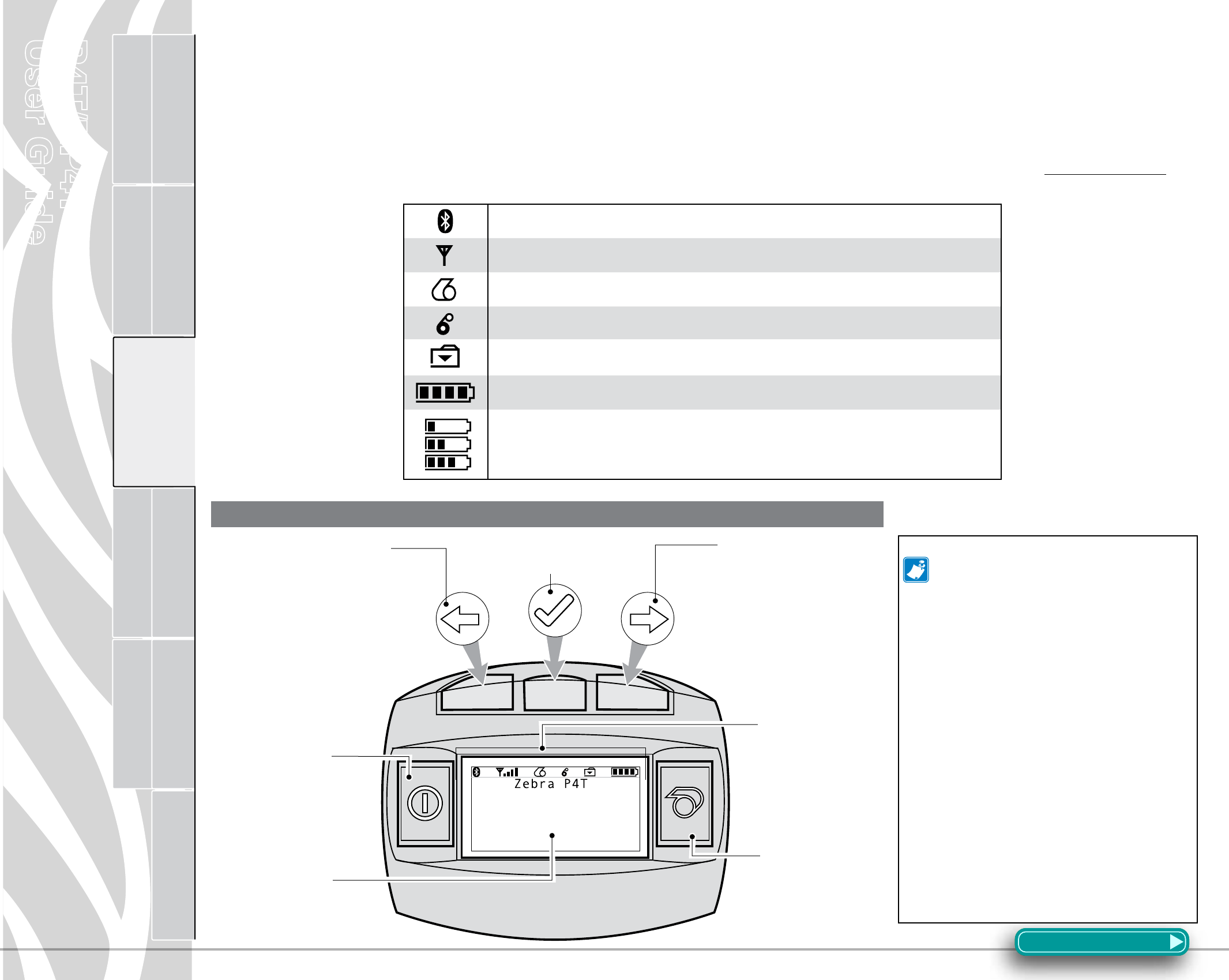
P4T/RP4T
User Guide
18
Printer Preparation Connecting the
Printer
Radio Regulatory
Information
RP4T Printers Maintenance Troubleshooting Specifications Appendices Index
P4T Overview
Manual
Introduction
Printer Controls
Operator Controls
The printer control panel has buttons for the power on/off and media feed functions and a display which provides information regard-
ing printer functions and application prompts. Two navigation keys provide easy selection of menu options.
The “Scroll Forward” button allows scrolling through the various options and settings. The “Scroll Back” button allows scrolling back
through previously viewed menus. Pressing the “Select” button selects the currently highlighted option or function.
The status icons at the top of the screen indicate the state of various printer functions per the table below. Refer to the Troubleshooting sec-
tion for more information on the printer status icons.
Indicates a Bluetooth connection is established. This icon is functional only on P4T Series printers with a
Bluetooth wireless option installed.
Indicates that the printer is associated with a wireless Local Area Network (LAN) using an 802.11b/g
compliant radio. This icon is functional only on a P4T Series printer with a WLAN wireless option installed.
A flashing icon indicates that the printer does not detect any label media. This could indicate an out of
media condition, or improperly loaded media.
A flashing icon indicates that the thermal transfer film is depleted.
A flashing icon indicates that data is being transferred to the printer.
A flashing outside element of the battery icon indicates low charge status. You should suspend any printing
operations and recharge or replace the Battery Pack as soon as is convenient.
Cycling charge level elements within the battery icon indicate the P4T Series battery is being charged by
the AC Adapter. Refer to Charger section of this manual.
Section Continues
If the printer displays:
“Please Recondition the Battery”
and beeps five times, the user
should recondition the battery to
return it to optimal operation.
To recondition the battery, charge
the battery fully overnight and then
use the printer until the printer
shuts down due to a low battery
condition.
Charge the battery again until it
is fully charged. At that point the
battery will be reconditioned. If the
battery is not reconditioned prop-
erly the indicated battery charge
level will indicate that there is more
charge remaining in the battery
pack than is actually available. Re-
conditioning performed as prompt-
ed by the printer will ensure accu-
rate capacity indication throughout
the serviceable life of the battery.
Figure 10 -P4T Series Printer Controls & LCD Icons
Scroll Forward Button
Press to scroll to the next
menu choice on the display.
Feed Button
Press to advance a
blank label or a pre-
determined length of
journal media.
Power Button
Press to turn unit on.
Press again to turn unit
off.
Scroll Back Button
Press to scroll to the previous
menu choice on the display.
.
Display
Indicates status mes-
sages and menu
prompts..
Printer Status
Icons
Refer to the Trouble-
shooting section for
more information on
the status icons.
Select Button
Press to select a menu choice on
the display.
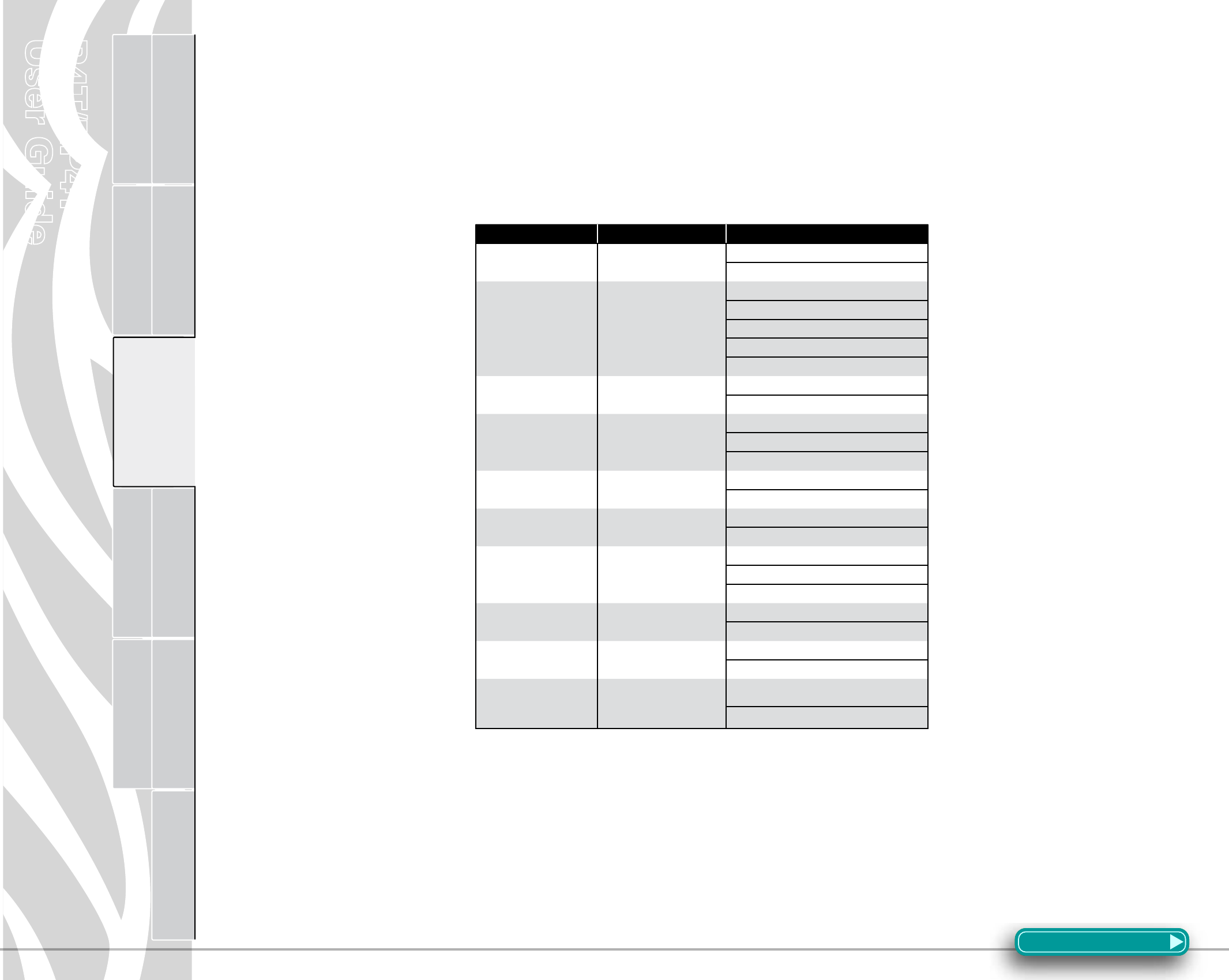
P4T/RP4T
User Guide
19
Printer Preparation Connecting the
Printer
Radio Regulatory
Information
RP4T Printers Maintenance Troubleshooting Specifications Appendices Index
P4T Overview
Manual
Introduction
Programmable LCD Settings
Inadditiontothestatusicons,theLCDonthecontrolpanelcandisplaymanyoftheprinter’ssettingsandfunctionsastextasdeter-
mined by the printer’s application. Applications can be written to allow the user to view and /or modify these settings using the scroll
andselectkeysonthedisplay.Refertothefollowingtablesforapartialsetofprinterfeaturesthatcanbeprogrammedtodisplayon
theLCD.
TheLCDhasabacklightingoptionwhichallowsviewingofthescreeninadarkenvironment,orprovidesbettercontrastinaverybright
environment.Useofthedisplaybacklightwilldecreasethetimetheprinterwillrunbetweencharges.Refertothesection“Extending
BatteryLife”formoreinformation.
Extended LCD Functions
Function Default setting Scroll & Select Options
Sensor Type Bar • Bar
• Gap
Baud Rate 19200
• 9600
• 19200
• 32400
• 57600
• 115200
Data Bits 8 • 7
• 8
Parity N (none)
• E (Even)
• N (None)
• O (Odd)
LCD Contrast 8 • Increase (15max.)
• Decrease (15 max.)
No-activity Timeout 120 sec. • Decrease (0 min.)2
• Increase (120 max.)
Audio Volume 3
• 1 – Low
• 2 – Medium
• 3 - High
Media Type Journal • Journal
• Label
LCD Backlight3Momentary On • Momentary On w/ time delay
• Off
Factory Reset (Resets
all to factory set
values)
No • No
• Yes
NOTES:
1: LCD menu options are under specific application control. Not all options may be available In your printer’s application.
2: A No-activity timeout value of “0” means the printer will remain on until powered off by the operator.
3: LCD Backlight turns on when any key other than FEED is pressed.
Section Continues
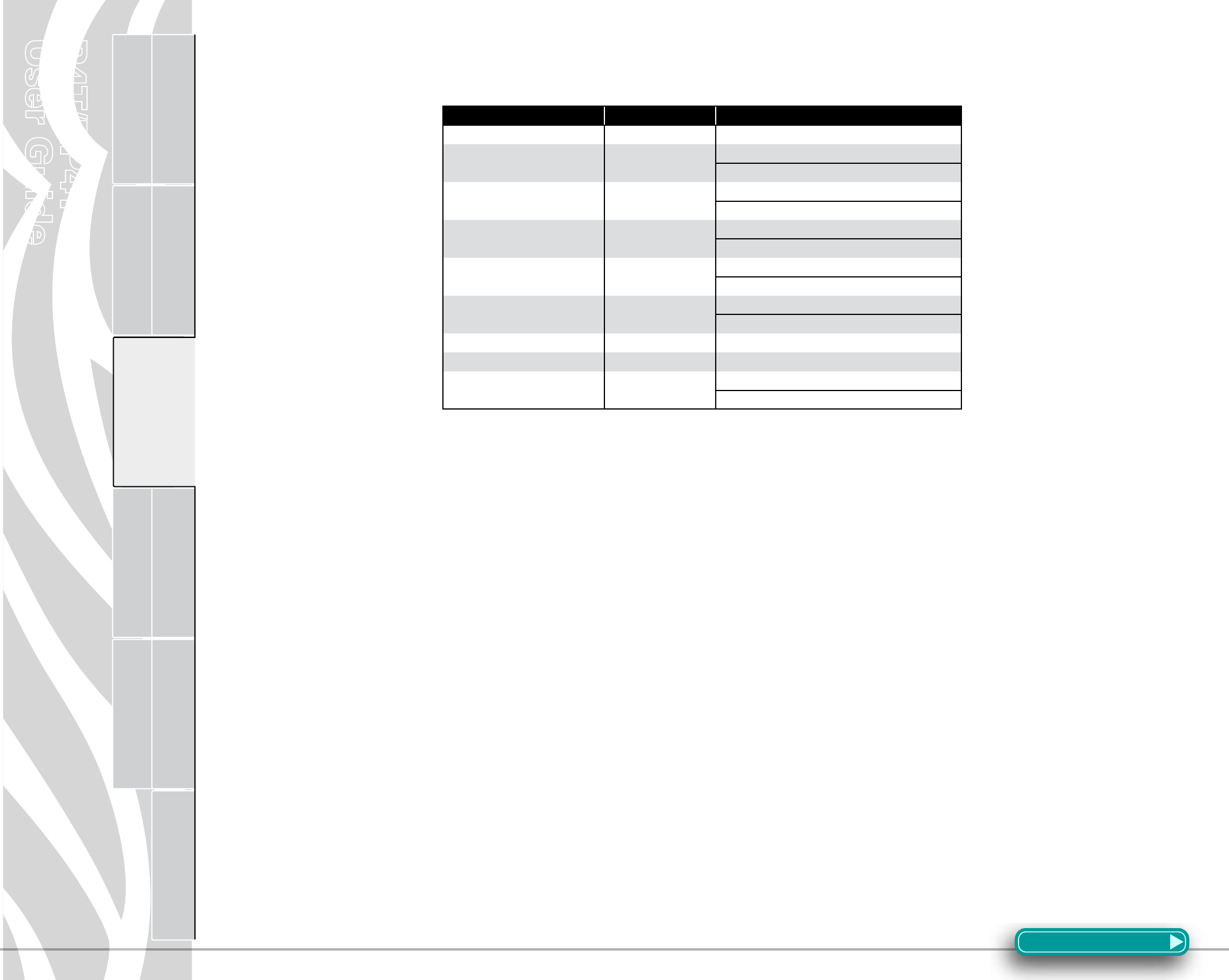
P4T/RP4T
User Guide
20
Printer Preparation Connecting the
Printer
Radio Regulatory
Information
RP4T Printers Maintenance Troubleshooting Specifications Appendices Index
P4T Overview
Manual
Introduction
Display Functions Not Controlled from the Keypad
WhiletheparametersinthistablecanappearonthedisplaytheycanbesetonlybyusingaPCrunningZebra’sLabelVistalabelcre-
ationprogramandadatacablelinktotheprinter.
Function Default setting Scroll & Select Options
WLAN ID Factory Set Value N/A
Tear-off Position (Top of Form) 00 • Increase (max. = +10)
• Decrease (min. = -120)
Network & RF Settings • All protocols On
• Protocols On or Off individually
Bridge Mode Off • Off
• On
DTR/VBUS-Power Off Off • On
• Off
Present-at 000 • Increase (max.= +120)
• Decrease (min. = 000
Bluetooth parameters n/a Displays current Bluetooth operating parameters
802.11g operating parameters n/a Displays current 802.11g WLAN parameters
Media Type Journal •Journal
•Label
Section Continues
